
Here VH-CLS with original DH Gipsy Queen engines departs Katherine NT in October 1967. Photo by Neil Follett
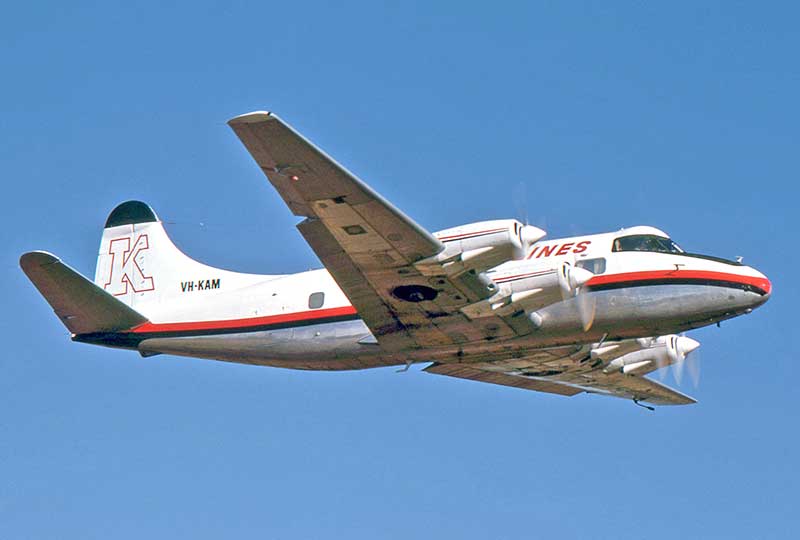
Riley Heron VH-KAM departs Griffith NSW in November 1977 for Melbourne on a scheduled Kendell Airlines service.
Photo by David Carter
The prototype DH.114 was constructed at the DH Head Office factory at Hatfield Airport, 20 miles north of London. It used Dove nose and tail sections joined by a lengthened fuselage and Dove outer wing sections. The initial design aimed for economical simplicity with a fixed undercarriage. The prototype G-ALZL was first flown at Hatfield on 10 May 1949 and after 180 hours of development test flying, the tailplane was redesigned with dihedral. Heron production commenced at Hatfield, transferring to the DH Hawarden works at Chester.
The prototype G-ALZL led a varied life as company demonstrator then airline and aerial survey flying in Europe before being ferried from Denmark to Australia in 1973 to become VH-CJS. She finished her long flying career carrying mining workers in the remote Gibson Desert in Western Australia.
Total Heron production was 149 aircraft, the main production development being the Heron 2 with retractable undercarriage. It became the preferred model, customers accepting the cost and weight penalty of the hydraulics for the 20 knot increase in cruising speed and lower fuel consumption. In 1961 the Royal Navy Fleet Air Arm replaced its five Doves (designated Sea Devons) with five Heron 2s (designated Sea Herons) for communications duties and as admiral's barges. One of the those Sea Herons later came to Australia as VH-NJP.
All Heron production models were powered by four 250hp DH Gipsy Queen 30 Mk.2 engines. 14 passenges or up to 17 if toilet removed.
DH.114 Heron 1B: fixed undercarriage, AUW 13,000 lbs, cruising speed 165 knots
DH.114 Heron 2 : retractable undercarriage, AUW 13,000 lbs, cruising speed 183 knots
DH.114 Heron 2D: retractable undercarriage, AUW 13,500 lbs, cruising speed 183 knots
First Heron seen in Australia was Heron 1B
ZK-AYV
in May 1952 which De Havilland arranged to be used as a demonstrator
during its delivery flight to NZ National Airways Corporation. Arthur
Butler,founder and Managing Director of Butler Air Transport Pty Ltd, Sydney
was impressed with the Heron and on 3
July 1952 BAT announced an order for two new Mk.1Bs. They were
delivered from England as VH-AHB and VH-ARB by BAT crews and operated
as 14
passenger airliners on the BAT network of scheduled services to NSW
country centres. Arthur Butler
later wrote "The
introduction of the DH Heron on services previously operated by Anson
and Dragon aircraft helped to improve our financial situation. The
Heron was faster than our DC-3s and many of our passengers preferred to travel in this modern four-engined aircraft."
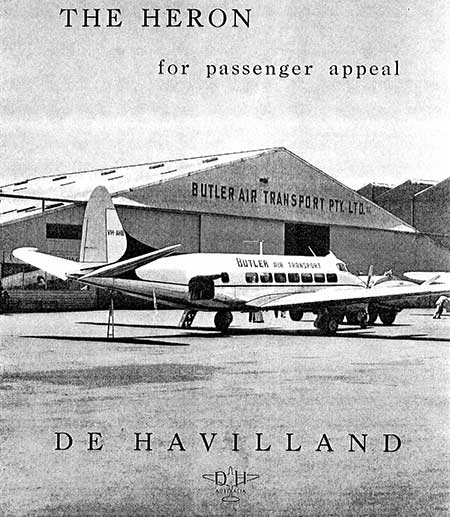
In 1958 two Herons were imported from New Zealand by Southern Airlines Pty Ltd, Melbourne for their scheduled services from Essendon Airport. It was a final gamble to attract customers by the small airline, which was struggling financially after replacing Ansons with DH. Doves. The Doves featured a female copilot/hostess and the route network was widened to include Bairnsdale, Kerang, Swan Hill, Warrnambool, King Island, Flinders Island, Launceston Tasmania, Millicent SA, Naracoorte SA and Adelaide. The two Heron 1Bs VH-GVH and VH-GVI were in service for less than a year before Southern Airlines ceased operations. The company's shareholding and route licences were taken over by Ansett-ANA and the Herons were sold.
By far the largest Australian Heron operator and definitely the most
influential was Connellan Airways Pty Ltd, Alice Springs NT. Founded in 1939
by E.J. "Eddie" Connellan who was determined
to create an air service to remote properties and small towns across central Australia.
First using Percival Gulls, he built up scheduled routes
over desolate country as far as Wyndham WA, carrying mail, supplies and
the occasional passenger. He also provided aircraft for the Alice Springs
Base of the Flying Doctor Service of Australia.
After WWII, Connellan planned new routes with bigger all metal aircraft, deciding on the Beech 18. He travelled to Manila in an unsuccessful attempt to acquire USAAF Beech C-45s being auctioned at Clark AFB in post-war aircraft disposals sales. Back home, to mprove services, he had little choice but to purchase DH.89 Rapide and DH.90 Dragonfly fabric covered biplanes then available in Australia.
Connellan Airways' developmental routes could never be profitable without Federal Government subsidies which E.J. Connellan gained over many personal visits to Canberra to lobby Federal Ministers for support. But with Government subsidies came stifling Government control over the operation of his airline - which was to cause E.J.Connellan huge frustration over the next 40 years. His every improvement was handicapped by bureaucrats 2000 miles away in Canberra and Melbourne determined to protect the public purse. He still wanted Beech 18s but was limited to the biplanes. By the time Beech 18s were finally introduced in the mid 1950s, E.J. Connellan had decided the DH.114 Heron was now the best type to expand and improve trunk routes. Thus started a six year battle to gain Government approval to import second-hand Herons, which in Connellan Airways service proved to be the success that Eddie had expected.
After WWII, Connellan planned new routes with bigger all metal aircraft, deciding on the Beech 18. He travelled to Manila in an unsuccessful attempt to acquire USAAF Beech C-45s being auctioned at Clark AFB in post-war aircraft disposals sales. Back home, to mprove services, he had little choice but to purchase DH.89 Rapide and DH.90 Dragonfly fabric covered biplanes then available in Australia.
Connellan Airways' developmental routes could never be profitable without Federal Government subsidies which E.J. Connellan gained over many personal visits to Canberra to lobby Federal Ministers for support. But with Government subsidies came stifling Government control over the operation of his airline - which was to cause E.J.Connellan huge frustration over the next 40 years. His every improvement was handicapped by bureaucrats 2000 miles away in Canberra and Melbourne determined to protect the public purse. He still wanted Beech 18s but was limited to the biplanes. By the time Beech 18s were finally introduced in the mid 1950s, E.J. Connellan had decided the DH.114 Heron was now the best type to expand and improve trunk routes. Thus started a six year battle to gain Government approval to import second-hand Herons, which in Connellan Airways service proved to be the success that Eddie had expected.
"After thorough investigation I chose the ungeared and unsupercharged Lycoming IO-540 engine of 300 hp. The English engineering business Aviation Traders, run by the famous Freddie Laker, wanted a guarantee of 50 aeroplanes to re-engine them with Rolls Royce built Continentals instead of the Lycomings I wanted. Airesearch in America countered with the requirement for 20 aircraft for a reasonable price. Jack Riley at Fort Lauderdale Florida* proposed he would do it for 8 aircraft at a reasonable price provided he had the blessing of De Havilland, access to their design data and the assistance of one or two of their design engineers.
This was difficult. De Havilland had already told me that my project was impossible. Herrod-Hempshall, who designed the Heron said it would not stand the extra power and the wings would crack. I went to Mexico City where the Bank of Mexico had a Heron which had been converted to four 340hp supercharged Lycoming engines and was having no trouble. It was done by a local company and as far as I could gather absolutely no design or stress calculations were made.
I took all the information I gathered back to Herrod-Hempshall in England. He said if we inspected the wing structure of the Mexican Heron, he was certain we would find find they were about to fall off with fatigue cracks. Back I went to Mexico and arranged for Pacific Airmotive in Dallas Texas to do a complete crack detection test. No cracks were found.
Back I went to Herrod-Hempshall. He was amazed. "I designed a better aeroplane than I thought" he said. De Havillands came to the party. They agreed to lend a couple of design engineers to Jack Riley as required and the whole project was on the way.
Jack Riley certified the conversion only to 12,500 pounds (5700 Kg) gross weight which was the maximum allowed for commuter airlines at that time in the United States. But because we were an airline there was no such restriction and we required the full original gross weight of 13,500 pounds so we undertook the whole certification program again.
We performed the actual conversion in our own workshops in the Alice Springs hangar with a saving of 800 pounds in weight.
The Lycoming Heron became the finest aircraft of its size in the world and also the most economical. It was a honey to fly. There was only one thing wrong with the Heron from our point of view. It had taken so long to gain Government approval to purchase them that, as usual, we already needed an aircraft twice the size because of the rate of growth of our traffic.
However the Herons continued to do a wonderful job for us for many years. We used all their fatigue life of 15,000 hours and had to respar them in order to begin their fatigue life all over again."
Each Riley Heron conversion carred out at Alice Springs took 2,000 man-hours. Four 300hp Lycoming I0-540 engines driving three bladed propellers were installed with fire-extinguisher systems in each power plant, the wings were re-lifed, cockpit avionics were upgraded, new air conditioning and the cabin was refurbished with a separate toilet compartment and 16 lightweight seats to allow two extra passengers. The modifications were approved for airline use by the Australian Department of Civil Aviation.
(*Riley Aeronautics Corporation specialised in aircraft modifications. Riley marketed a range of DH.104 Dove conversions with Lycoming engines culminating in the Riley Turbo Exec 400 with 400hp Lycomings and redesigned swept tail fin.
Riley's Lycoming Heron conversion was marketed in USA as the Riley Turbo Liner and achieved sales success with many airlines.)
By 1979 Connellan Airways, now renamed Connair Pty Ltd was operating Fokker F.27 and DC-3 equipment alongside its remaining Herons and carrying 70,000 passengers a year. But Eddie Connellan was a tired and disillusioned man, fed up with constant conflict with Government, the airline pilots union and his own Board of Directors. A terrible personal blow had been the tragic death of his son Roger Connellan, a Connair Check and Training captain and destined to take over the airline from his father: on 5 January 1977 a disgruntled pilot who had been dismissed by Connair dived a stolen Beech Baron into the Connair administration building at Alice Springs Airport, killing himself, Roger Connellan, company engineers Mark Chittoni, Ron Dymock and assistant Liana Nappi. Serious burns were sustained by engineers Tony Byrnes, Kym Hansen and 20,000 hour Connair veteran pilot George Tayor.
During 1979 an attempt to sell his airline to Trans-Australia Airlines was scuttled by the NT Government. E.J.Conellan negotiated a sale to East-West Airlines, Sydney effective 14 March 1980. This had the blessing of the NT Government despite Connellan's prediction that major airline costs on his modest routes doomed the takeover to fail. East-West formed a new company Northern Airlines based at Darwin, which lasted less than a year, announcing in December 1980 they were shutting down with losses of millions of dollars.
Former Connair Riley Herons, including those taken over by the ill-fated Northern Airlines, were acquired by a variety of Australian third-level airlines and flew on in passenger service into the 1990s. Their sometimes complex ownership trails are detailed below:
| .52 | Built by De Havilland Aircraft Co Ltd, Hatfield. Production Heron 1B The first six Herons were built at the DH works at Hatfield Aerodrome Herts, then Heron production continued at the DH factory at Hawarden Aerodrome, Chester |
| Built to the order of Butler Air Transport, Australia | |
| 5.9.52 | Registered G-AMUK Butler Air Transport Pty Ltd, Kingsford Smith Airport Sydney NSW |
| 15.9.52 |
Handed over to BAT at DH company
headquarters Hatield, accepted by BAT Operations Manager Captain Tom Young |
| 23.9.52 | British CofA issued, 14 passenger seats |
| 23.9.52 | Departed Hatfield on delivery flight to Australia crewed by Captain T.R.Young, Captain R.Baker, engineer C.Hobday |
| 4.10.52 | Arrived Sydney Airport |
| 8.10.52 | Registered VH-AHB Butler Air Transport Pty Ltd, Kingsford Smith Airport Sydney NSW Named RMA Warrawee |
| 4.11.52 | Entered BAT scheduled operations, first service Sydney-Temora NSW. 14 passenger seats and toilet. |
| 56 | BAT
retired both Herons VH-AHB & VH-ARB and offered them for sale. The
sale proceeds went towards two new Vickers Viscounts VH-BAT &
VH-BUT. BAT Ops Manager Tommy Young later said "The Herons turned out to be pretty useless. They had a very low payload and were totally unsuitable for our class of work. Arthur Butler chose the Herons and Viscounts himself, the selection was never discussed with me. The Viscounts were the most beautiful aeroplane I have ever flown, but they were a bit ahead of their time and the traffic just wasn't there for them. We used them on all our routes but the only one on which the Viscounts made money was Sydney-Coolangatta." |
| 28.3.56 | Change of ownership: Field Aircraft Services Ltd, Sydney NSW |
| 14.5.56 | Change of ownership: Aviation Sales Pty Ltd, Sydney Airport NSW |
| 10.6.56 | Struck-off Australian Register as sold abroad |
| 11.7.56 | Restored to British Register G-AMUK: Gulf Aviation Co Ltd, Bahrein |
| Ferried from Sydney to Bahrein | |
| 15.8.67 | Change of ownership: Flying Facilities Ltd, Gatwick |
| 26.8.69 | Change of ownership: Tradair Ltd, Southend |
| 7.72 | Scrapped at Southend |
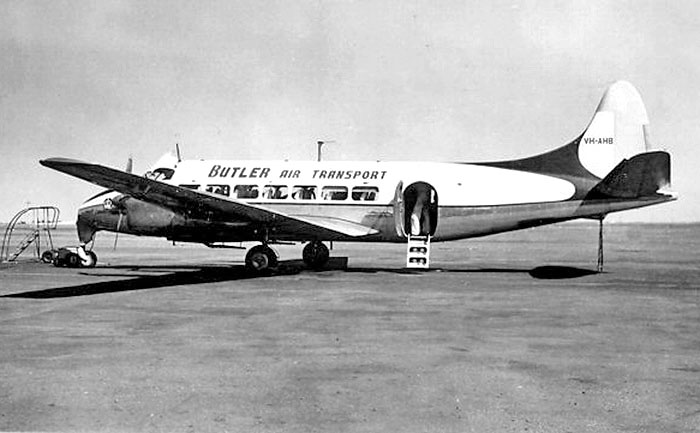
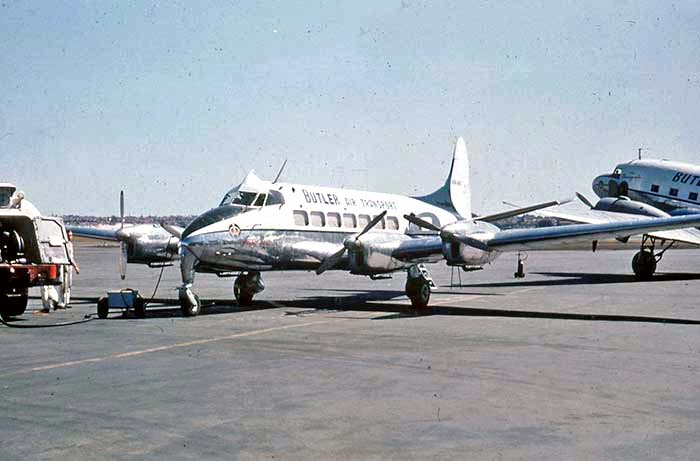
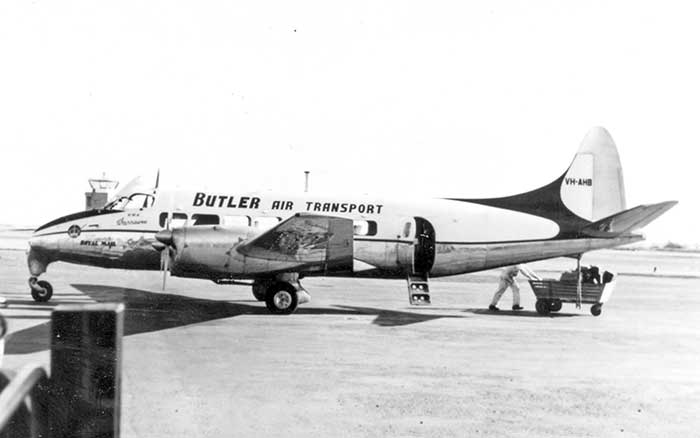
| .53 | Built by De Havilland Aircraft Co Ltd, Hawarden Aerodrome, Chester. Production Heron 1B |
| Built to the order of Butler Air Transport, Australia | |
| 16.10.53 | Registered G-ANFE De Havilland Aircraft Co Ltd, Hatfield |
| 10.11.53 | British CofA issued |
| 11.11.53 | Handed over to Butler Air Transport. Ferried to Australia by BAT crew |
| 17.12.53 | Registered VH-ARB Butler Air Transport Pty Ltd, Kingsford Smith Airport, Sydney NSW Named RMA Warrawa |
| 56 | BAT retired both Herons VH-AHB & VH-ARB and offered them for
sale. The sale proceeds went towards two new Vickers Viscounts VH-BAT
& VH-BUT. |
| 20.7.56 | Struck-off Australia Register as sold abroad |
| 30.7.56 | Restored to British Register G-ANFE: Gulf Aviation Co Ltd, Bahrein |
| Ferried from Sydney to Bahrein | |
| 15.8.67 | Change of ownership: Aerocontracts Ltd, Gatwick |
| 5.4.68 | Registered TN-ABA Cogeair, Kinshasa Zaire |
| 11.7.69 | Crashed Ruddervoorse, Belgium while being ferried to England |
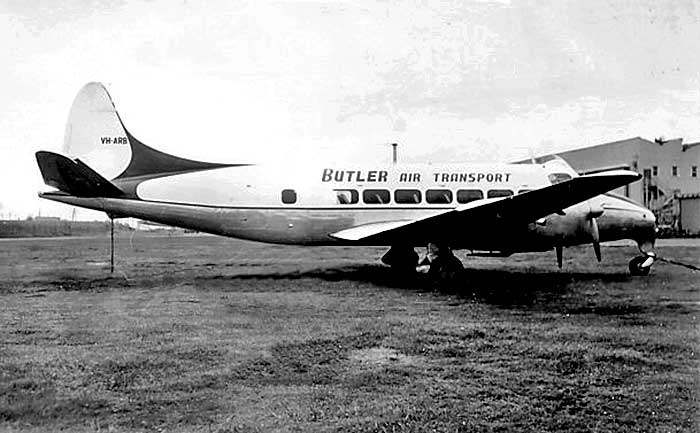
| 3.57 | Built by De Havilland Aircraft Co Ltd, Hawarden Aerodrome, Chester. Production Heron 2D |
| 25.4.57 | Handed over to Associated Airlines. Fitted out to Heron Executive Special configuration:
the passenger cabin divided into two compartments.The rear compartment
has 4 large armchairs in pairs facing each other across a wood panelled
folding table. The forward compartment has two armchairs with smaller
folding tables and provision for installation of a buffet. |
| 27.4.57 | VH-ASH visited Edinburgh-Turnhouse on crew training |
| 29.4.57 | Registered VH-ASH Associated Airlines Pty Ltd, Melbourne Victoria |
| Associated
Airlines was a private operation formed in 1937 by Broken Hill Pty Ltd
to provide executive transport between Australian
mining enterprises. First aircraft were Lockheed 12As | |
| 2.5.57 | Accepted from DH by Associated Airlines Chief Pilot Captain Len M.Diprose. Delivered to Australia by chief pilot Captain Len Diprose, copilot Roger W. Jamieson (Manager DH New Zealand) and engineer A.C.Dalziel |
| 2.5.57 | Delivered via Southend en route to Australia |
| 18.5.57 | VH-ASH arrived Melbourne-Essendon on delivery. Australian certification inspection by De Havilland Aircraft Pty Ltd at Bankstown Aerodrome, Sydney At that time Associated Airlines was based at the Commonwealth Aircraft Corporation airfield Fishermans Bend, Melbourne but moved its operations to Essendon in July 1957 when a new hangar and administration office was completed. It remains based there today with a fleet of executive jets. |
| 9.9.65 | Undercarriage folded during landing Essendon, minor damage |
| 68 | Offered for sale by Associated Airlines, replaced by Grumman G.159 Gulfstreams |
| 3.5.68 | Struck-off Australian Register, sold to USA |
| 3.5.68 | Registered N210FA Omni Investment Corp, Washington DC |
| 3.5.68 | N210FA departed Essendon for Sydney-Bankstown to have ferry tanks installed by Hawker De Havilland |
| .68 | Continued delivery from Sydney to USA |
| 68 | Leased to Florida Airlines, Miami Florida |
| 24.7.68 | Reregistered N998SA Sun Airlines, St Louis Missouri |
| 25.4.69 | Change of ownership: RayJay Corporation. Converted to Riley Heron 2 with Lycoming engines |
| 6.5.72 | Reregistered N3FB Fischer Brothers Aviation, Gallion Ohio operating as Allegheny Commuter |
| 18.12.78 | Written off. Struck an airport vehicle crossing the duty runway while landing Cleveland-Hopkins Ohio. Aircraft wrecked, no fatalities among the 2 crew and 15 passengers. |

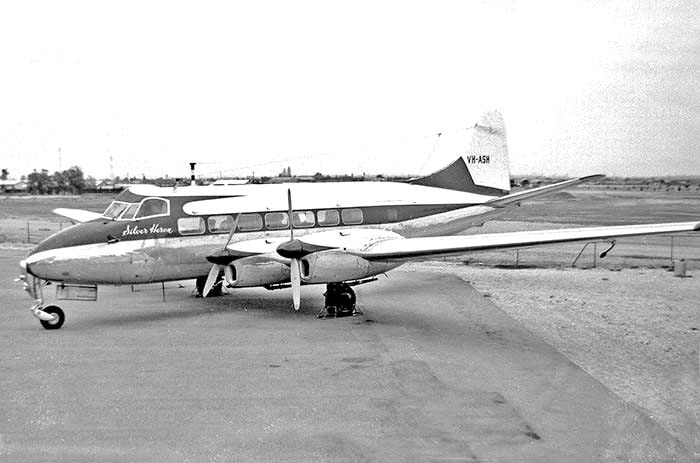
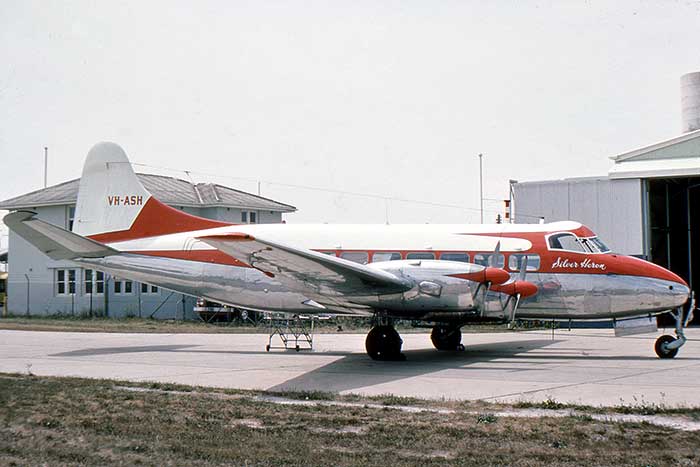
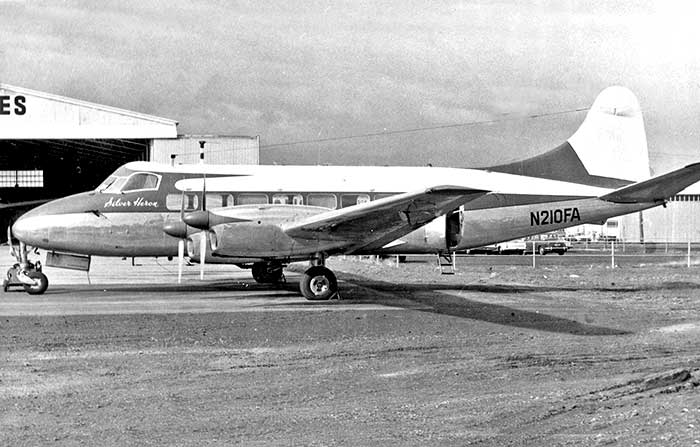
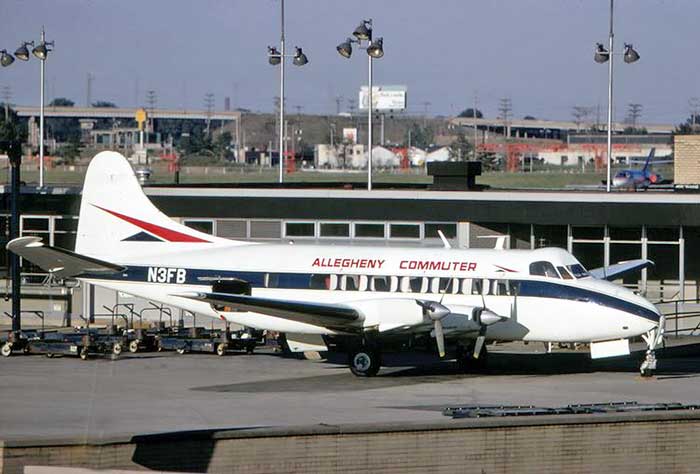
Keith Simpson collection
| .53 | Built by De Havilland Aircraft Co Ltd, Hawarden Aerodrome, Chester. Production Heron 1B |
| 27.10.53 | Registered ZK-BBO New Zealand National Airways Corporation, Wellington NZ |
| 8.12.53 | Reregistered ZK-BEQ. Named Mako (bellbird) NZNAC requested the change to indicate "Elizabeth Queen" because this new NZNAC aircraft had been selected to carry Queen Elizabeth II on her forthcoming NZ royal tour. |
| 27.12.53 | Acceptance date by NZNAC. Ferried to New Zealand |
| Sold to Southern Airlines, Melbourne Australia | |
| 18.1.58 | ZK-BEQ
departed Auckland on delivery flight to Australia, under comand SAL Captain A.G.Gifford. Refuelled at Norfolk
island, Coffs Harbour and Sydney, to Melbourne-Essendon |
| 26.1.58 | Registered VH-GVH Southern Airlines Ltd, Melbourne-Essendon Vic |
| 27.1.58 | Displayed at an airshow at Bairnsdale Vic |
| 15.2.58 | Named Queen of the South in a ceremony at Southern Airlines port Naracoorte SA, where local fundraising had contributed to the purchase of the two Herons. |
| 1.11.58 | Southern Airlines ceased operations. On 22.12.58 Ansett Transport Industries took over the Southern Airlines route licences. The SAL Doves and Herons were not included in the purchase and were advertised for sale by the SAL liquidators. |
| 6.1.59 | Change of ownership: Qantas Empire Airways, Sydney NSW Acquired by Qantas on behalf of Fiji Airways, in which it was a major shareholder. |
| 3.59 | Delivered to Fiji |
| 23.4.59 | Registered VQ-FAL Fiji Airways Ltd, Suva, Fiji |
| 11.12.65 | Ran off runway into ditch landing Ura airstrip, Taveuni Island, Fiji. Pilot and 17 passengers unhurt. Damaged beyond economical repair |
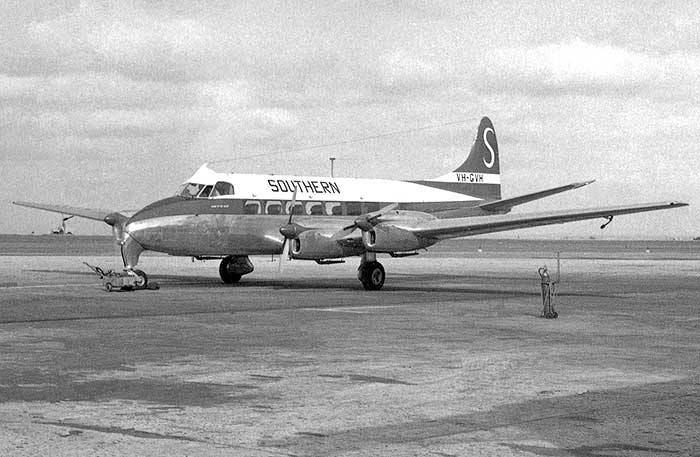
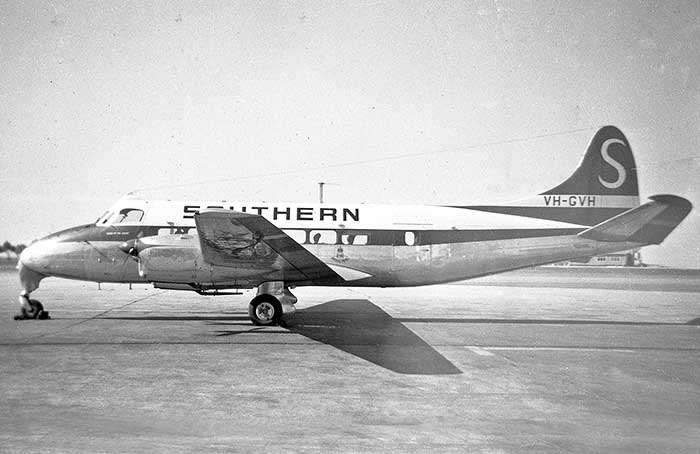
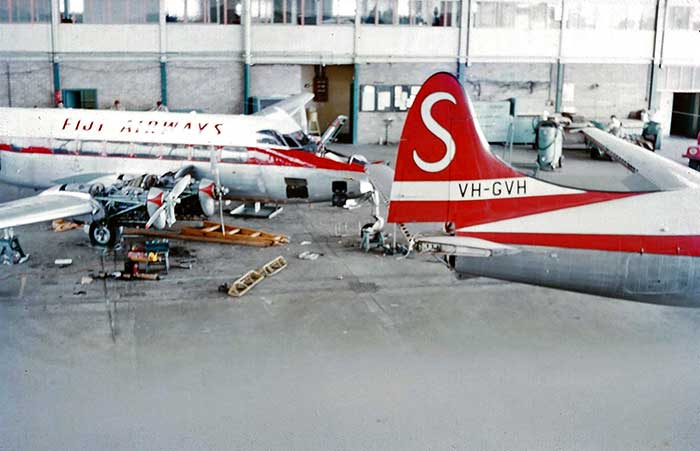
Photo: Civil Aviation Historical Society
| .53 | Built by De Havilland Aircraft Co Ltd, Hawarden Aerodrome, Chester. Production Heron 1B |
| 19.12.52 | Registered ZK-BBN New Zealand National Airways Corporation, Wellington NZ |
| 22.4.53 | Acceptance date by NZNAC. Delivered to NZ |
| Named Matuhi (bush bird) | |
| 31.7.57 | Retired, stored pending sale |
| 1.58 | Sold to Southern Airlines Ltd, Essendon Airport, Melbourne Vic |
| 22.1.58 | Test
flown at Christchurch by Southern Airlines Captain Joe Salfass.
Aircraft was repainted in Southern Airlines scheme as VH-GVI |
| 29.1.58 | VH-GVI
departed Christchurch on delivery to Australia under command SAL Captaon A.G.Gifford. Refuelling stops at Auckland, Norfolk Island, Coffs Harbour, Sydney. Arrived Essendon 1.2.58 |
| Australian certification inspection at Essendon | |
| 4.3.58 | Registered VH-GVI Southern Airlines Ltd, Essendon Airport, Melbourne Vic |
| 4.3.58 | Inaugural SAL passenger service, Melbourne-Bairnsdale return |
| 3.58 | Named Queen of the Islands in a ceremony at Flinders Island |
| 1.11.58 | Southern Airlines ceased operations. On 22.12.58 Ansett Transport
Industries took over the Southern Airlines route licences. The SAL
Doves and Herons were not included in the purchase and were advertised for sale by the SAL liquidators. |
| 5.1.59 | Change of ownership: Qantas Empire Airways, Sydney NSW Acquired by Qantas on behalf of Fiji Airways, in which it was a major shareholder. |
| 24.2.59 | Registered VQ-FAX Fiji Airways Ltd, Suva |
| 9.11.66 | Damaged landing Suva, Fiji. During repair serious corrosion was found and aircraft was written-off. |
| Airframe donated to airport fire service Nausori Airport, Suva for practice exercises |
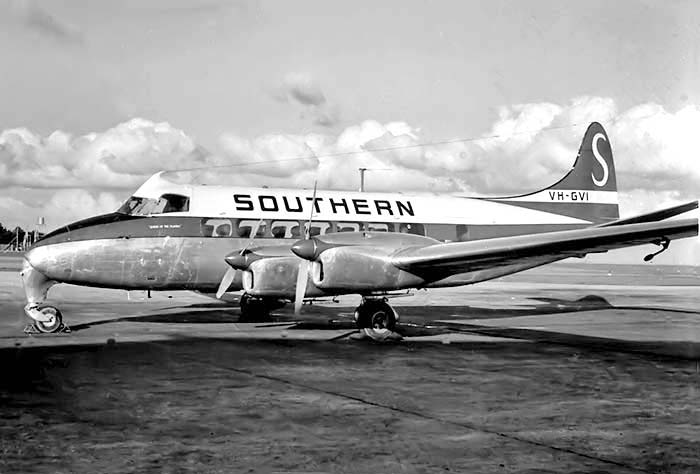

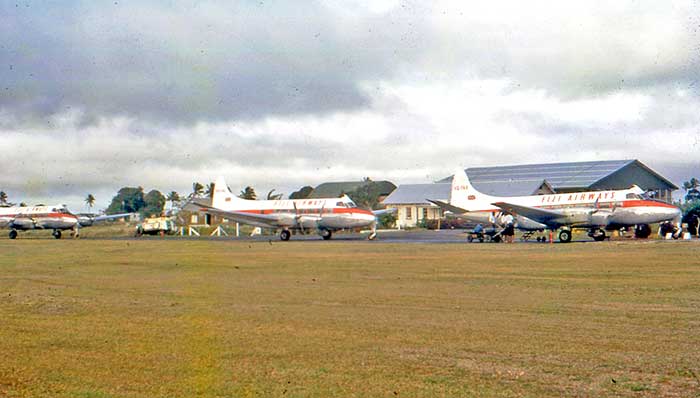
Photo by Gordon Clear, courtesy South Australian Aviation Museum
| .55 | Built by De Havilland Aircraft Co Ltd, Hawarden Aerodrome, Chester. Production Heron 2 |
| 9.6.55 | Registered VT-DHH Indian Airlines Corporation |
| .63 | Herons
VT-DHH & VT-DHI purchased early 1963 by Connellan Airways from Indian Airlines. Both had
been retired for some years at New Delhi and were unairworthy at the time of purchase. Both were flown to Australia |
| 28.3.63 | Registered VH-CLR Connellan Airways Ltd, Alice Springs NT |
| Both
Herons flown to Australia together. VH-CLR was flown by veteran airline
pilots Harry Purvis and Damian Miller with Roger Connellan, Eddie
Connellan's son. | |
| 8.4.63 | VH-CLR arrived Alice Springs NT from India, three days behind VH-CLT |
| 13.4.63 | VH-CLR
ferried Alice Springs to Sydney-Bankstown for Australian certification inspection and
mandatory modifications by Hawker De Havilland Australia |
| 22.7.63 | Delivered Bankstown-Alice Springs to enter airline service |
| 10.7.70 | Connellan Airways Pty Ltd operating name changed to Connair Pty Ltd Aircraft were progressively repainted in a new yellow and white "CONNAIR" scheme |
| 13.12.72 | Struck-off Register, sold to Canada |
| 12.72 | Registered CF-FZP Saunders Aircraft Corporation, Gimli Manitoba |
| 14.1.73 | CF-FZP noted Fairoaks, England during delivery flight to Canada |
| Rebuilt at Gimli Manitoba as Saunders ST-27. Tenth conversion, Saunders c/n ST27-010. (The ST-27 was a rebuilt DH.114 airframe with a 8 ft 6 inch (260cm) fuselage stretch, enlarged tailplane, powered by two PT-6A turboprops which could carry 24 passengers | |
| .74 | Reregistered C-FFZP Skywest Airlines (did not enter service) |
| 5.75 | Change of ownership: Air Atonabee Ltd, Toronto Ontario |
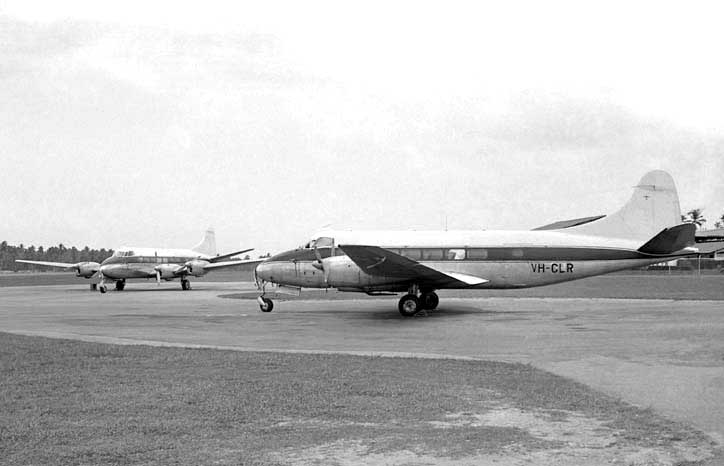
VH-CLR's previous registration VT-DHH has been touched up for the ferry. Photo by David Taylor
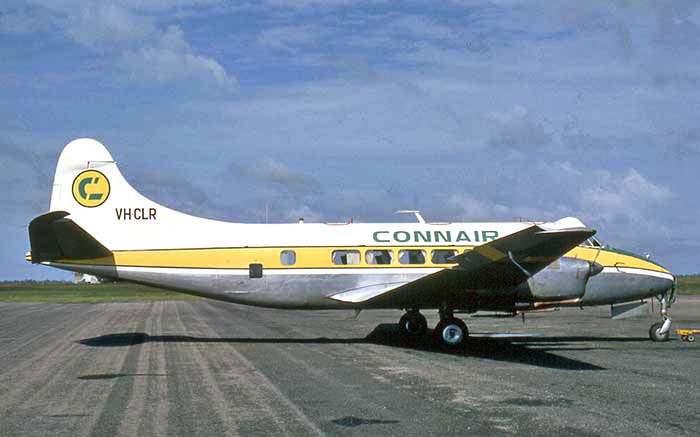
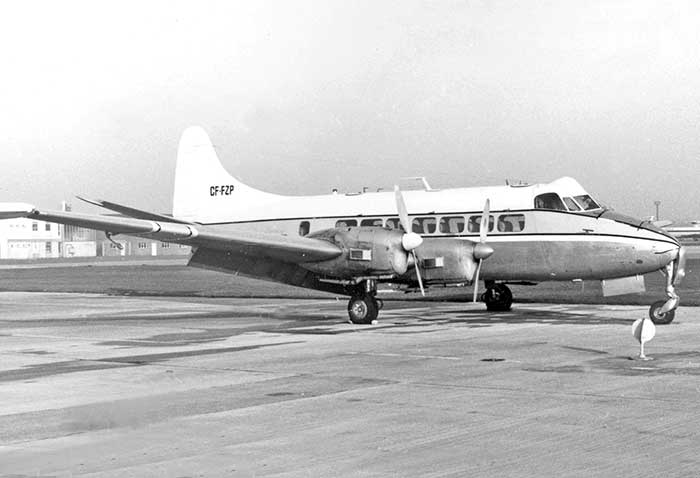
Photo by David Freeman
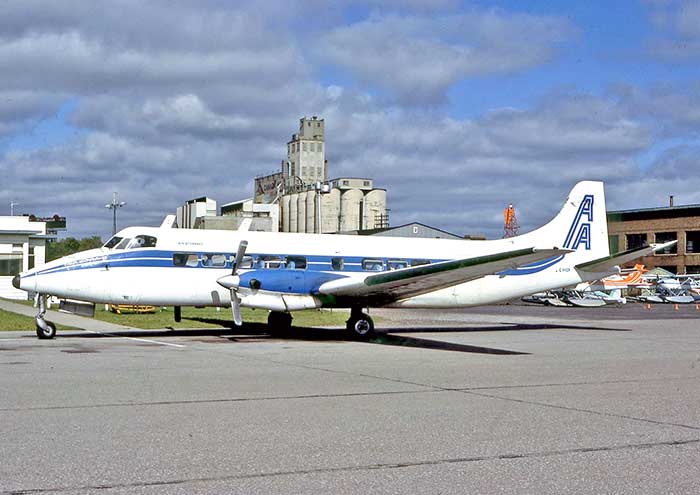
Photo by Geoff Goodall
| .55 | Built by De Havilland Aircraft Co Ltd, Hawarden Aerodrome, Chester. Production Heron 2 |
| 15.7.55 | Registered VT-DHI Indian Airlines Corporation |
| 3.63 | Herons VT-DHH & VT-DHI purchased by Connellan Airways from Indian Airlines. Both had been retired for some years and were unairworthy at the time of purchase. |
| 29.3.63 | Registered VH-CLT Connellan Airways Ltd, Alice Springs NT |
| Both Herons flown to Australia together. VH-CLT was flown by veteran Australian airline pilot and now professional ferry pilot Captain Bryan Monkton, with copilot Charles Osborne. | |
| 5.4.63 | VH-CLT arrived Alice Springs NT on delivery from India, followed by VH-CLR three days later |
| Used for crew training at Alice Springs | |
| 6.7.63 | Ferried
Alice Springs to Sydney-Bankstown for Australian certification
inspection and mandatory modifications by Hawker De Havilland Australia |
| 63 | Entered passenger service with Connellan Airways |
| 69-70 | Rebuilt at Alice Springs by Connellan Airways as their first Riley Heron conversion
with four 300hp Lycoming I0-540 engines driving three bladed
propellers. |
| 12.3.70 | Civil Register aircraft type changed to a new DCA
type designation DH114/2E/A1 |
| 10.7.70 | Connellan Airways Pty Ltd operating name changed to Connair Pty Ltd. Aircraft were progressively repainted in a new yellow and white "CONNAIR" scheme |
| 6.8.71 | Starboard main gear collapsed during landing Alice Springs, minor damage |
| 25.12.74 | Survived Cyclone Tracy
at Darwin. Connair staff parked it in a hangar overnight, prepared for
the high winds with brakes set and all 3 wheels chocked, controls
locked internally and externally and tail anchored to a tug. The rear
freight locker was hastily filled with cartons of beer brought from a
freight shed to weigh the aircraft down. Next morning Connair pilot David Frederickson used its HF radio to contact the Katherine DCA Flight Service Unit to pass news of the extent of destruction in Darwin. No other Darwin radio transmitters were operational after the cyclone and numerous essential messages were passed on behalf of police, government, emergency services and the military. |
| 14.3.80 | Eddie Connellan sold Connair and its assets to East West Airlines, Tamworth NSW. East West formed a new operation Northern Airlines to take over the Connair routes |
| 18.6.80 | Change of ownership: Northern Airlines Pty Ltd, Darwin NT |
| 6.2.81 | Northern Airlines ceased operations. |
| 30.7.81 | Change of ownership: Southern Airways (Operations) Pty Ltd, Adelaide SA |
| 8.8.81 | CLT
noted at Adelaide-Parafield, no airline titles; noted in hangar 4.10.81
being repainted blue and white with "Southern" titles. |
| 3.83 | Change of ownership: Airlines of Tasmania Pty Ltd, Launceston Tasmania Named Spirit of Bass Strait |
| 19.3.83 | Delivered Parafield-Essendon-Launceston |
| Flown on scheduled passenger services within Tasmania and to Bass Strait islands and Melbourne | |
| 16.10.85 | Total flying time 21,169 hours |
| 87 | Retired at Launceston. Dismantled in the company hangar by 3.88 |
| 22.6.89 | Struck-off Register |
| c89 | The fuselage shell was moved by an Airlines of
Tasmania engineer to a hunting lodge west of Woodbury, Tasmania for use as temporary accommodation |
| 2002 | CLT fuselage by now used as a storage shed at the hunting lodge, roughly painted in camouflage. Reportedly still there in 2013. |
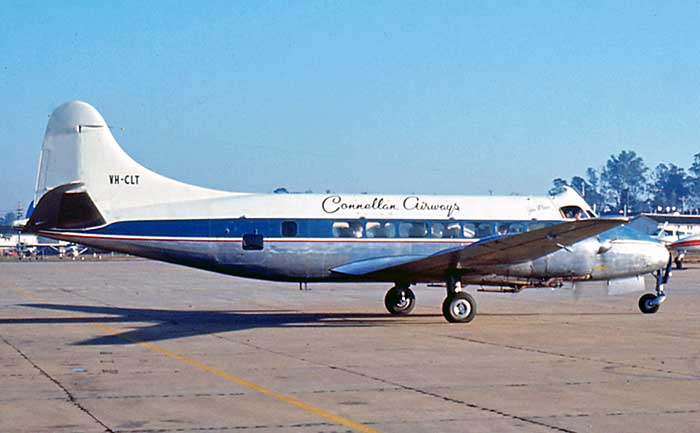
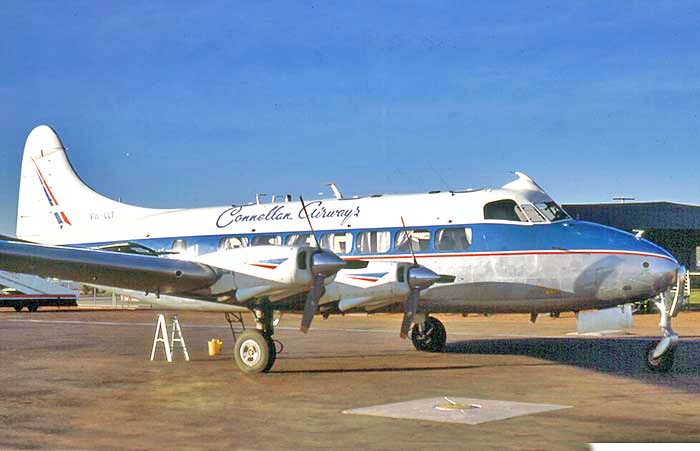
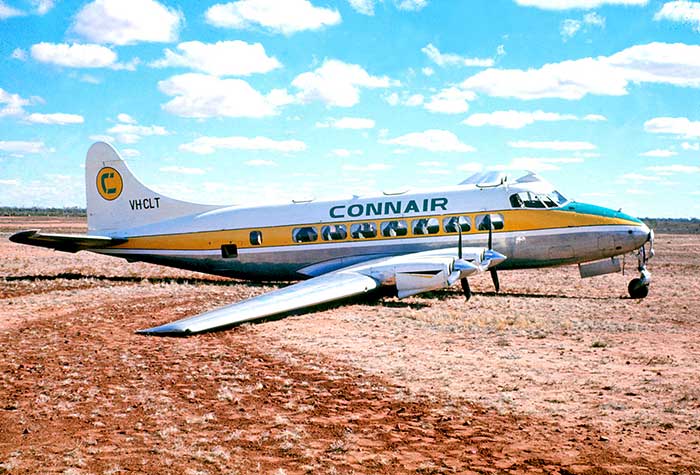
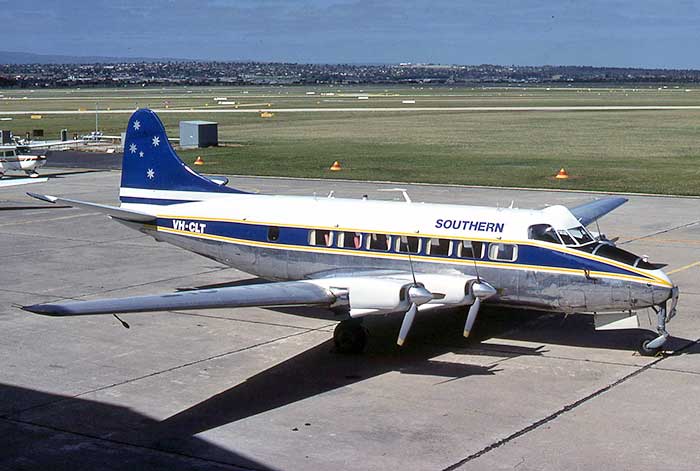
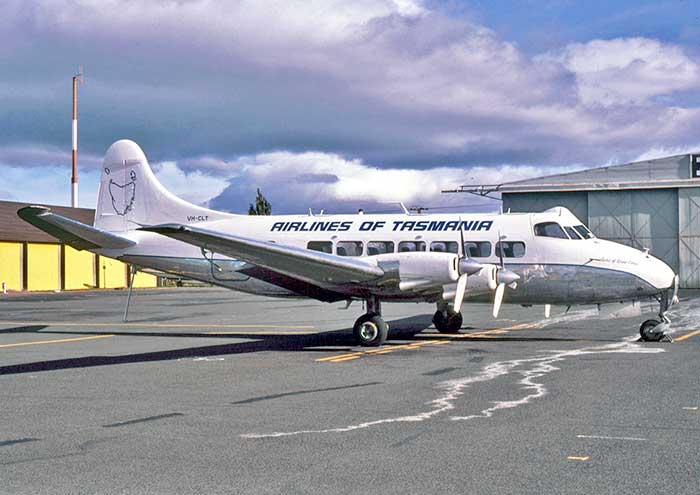
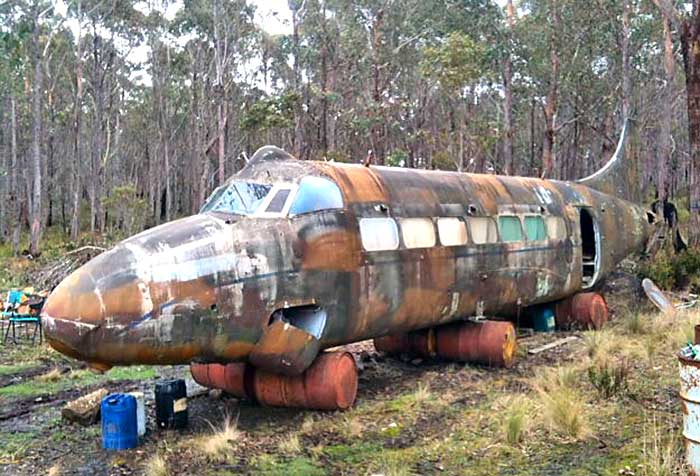
Photo Gerard Brereton via Ron Cuskelly
| .55 | Built by De Havilland Aircraft Co Ltd, Hawarden Aerodrome, Chester. |
| 19.6.55 | Registered VT-DHE Indian Airlines Corporation |
| 5.61 | Sold to Banwarilal India |
| 3.63 | Sold to The Hundu Times |
| 4.63 | Sold to Kasturi Lal and Sons |
| .65 | Sold to aircraft dealers Aerocontracts Ltd, Gatwick Airport, London. No British CofA issued, aircraft held in India pending resale |
| 5.65 | Sold to Connellan Airways Ltd, Alice Springs NT |
| 28.5.65 | Cable
to DCA from Aerocontacts Ltd to advise that they have sold VT-DHE 14067
to Connellan Airways. Aircraft is located at Bombay. Scheduled to be
delivered June 1965 by British ferry pilots |
| 15.6.65 | Registered G-ATFE Aerocontracts Ltd, Gatwick |
| 6.65 | G-ATFE delivered from India to Alice Springs by a British ferry crew. |
| 28.6.65 | Struck-off British Register |
| 65 | Parked
outside at Alice Springs for six months reportedly due delays in
availability of maintenance for Australian certification overhaul in
Sydney. |
| 1.3.66 | Entered
Connellan Airways hangar at Alice Springs to be prepared for ferry
flight to Sydney-Bankstown for Australian certification inspection and
modifications by Hawker de Havilland Australia. |
| 4.10.66 | noted at Bankstown completed overhaul at HDeH, painted as VH-CLS metallic with white upper surfaces. |
| 21.10.66 | Registered VH-CLS Connellan Airways Ltd, Alice Springs NT |
| 10.66 | Ferried Bankstown-Alice Springs where painted in Connellan Airways blue and white scheme |
| 10.7.70 | Connellan Airways Pty Ltd operating name changed to Connair Pty Ltd. Aircraft were progressively repainted in a new yellow and white "CONNAIR" scheme |
| 19.11.71 | port flap burnt by engine start fire at Victori River Downs Station NT |
| 10.73 | Completed rebuild at Alice Springs by Connellan Airways as Riley Heron 2E with four 300hp Lycoming I0-540 engines driving three bladed propellers. Australian certified for 2 crew and 16 passengers. DCA type designation DH114/2E/A1 |
| 24.12.74 | Evacuated from Darwin to Katherine NT in the early evening ahead of approaching Cyclone Tracy.
Later that night Connair pilots flew VH-CLS back to Darwin returning company DC-3 pilots who had flown Connair DC-3s VH-EWE, -MIN and -PWM from Darwin to Katherine. The Heron crew made 3 approaches but were unable to land due severe wind gusts and wind shear, returned to Katherine. Next morning after the destruction at Darwin, VH-CLS was the second aircraft to land at 11.30am. It was immediatey used to replace Heron VH-CLT for HF radio communications to DCA Flight Service Units, providing the only outside radio contact on the ground at Darwin that day. VH-CLS then joined the airlift to evacuate citizens whose homes had been destroyed. |
| 23.10.75 | Crashed destroyed on landing approach Cairns Qld. Captain G. Edwards, First Officer Peter Scaife, Hostess Lorraine French. All 11 persons on board died. |
| The
aircraft was operating Connair Flight 1263 Alice-Springs-Mount
Isa-Cairns. Making an ILS approach to Cairns at night in rain and
thunder storms, the crew reported not visual at the minima. Tower
instructed them to make a Missed Approach procedure climbing to 3700
feet. The investigation determined that instead the Captain remained at
a low altitude, probably marginally below the cloud base and was turning
back to the runway through a turn of 270 degrees when the aircraft
impacted terrain in a sugar cane field just north of the airport. |
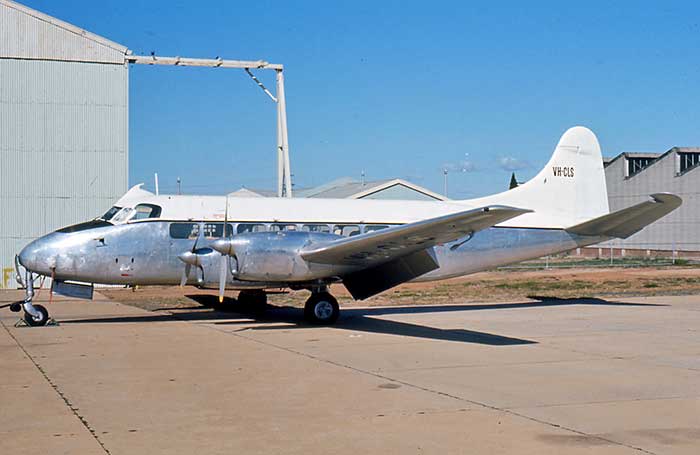
Photo by Roger McDonald
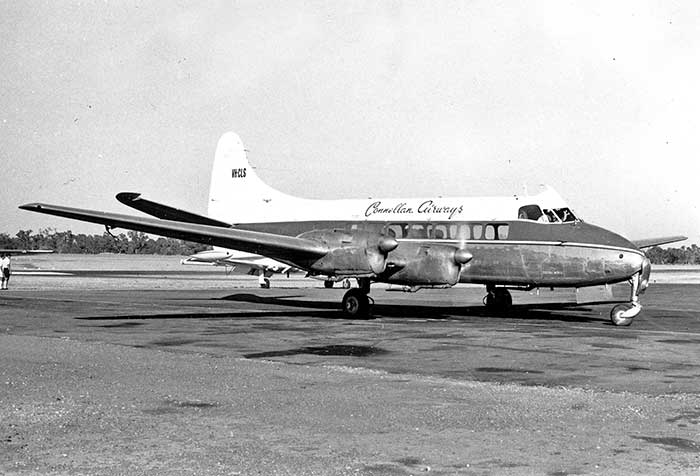
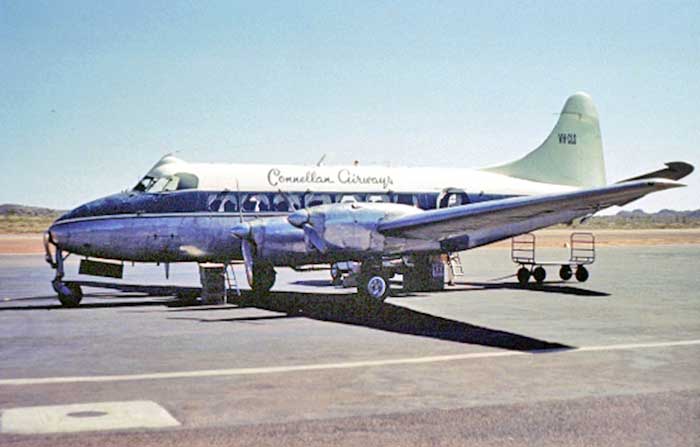
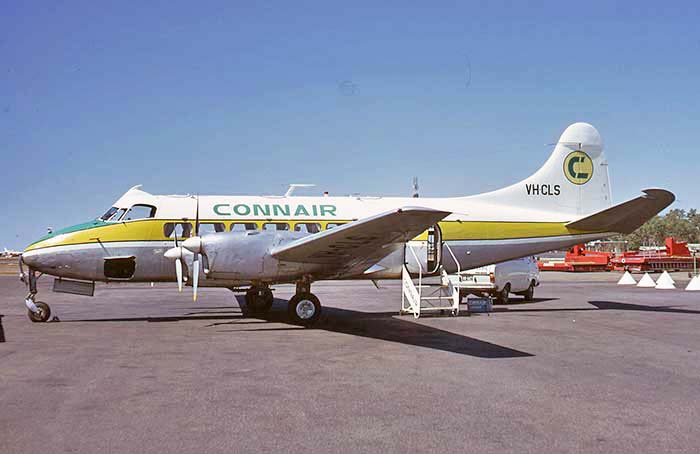
| .58 | Built by De Havilland Aircraft Co Ltd, Hawarden Aerodrome, Chester. Production Heron 2D |
| 18.4.58 | Delivered new to West German Air Force/Luftwaffe as CA+002 |
| Luftwaffe
acquired two new Herons for military communications including personal
transport of Chief of Staff. They were the first British built aircraft
to serve in the post-war Luftwaffe which was largely US backed. Both
these Herons were to later come to Australia for Connair. | |
| 30.8.62 | Registered G-ASCX Ferranti Ltd, Manchester Based Machester-Ringway, one of several Herons used by Ferranti for courier services between its various plants manufacturing avionics, radar and defence electronic systems. |
| 1.9.62 | British CofA issued |
| 2.70 | Sold to Connellan Airways Ltd, Alice Springs NT |
| 6.5.70 | G-ASCX arrived Alice Springs on delivery flight ex UK |
| 10.7.70 | Connellan Airways Pty Ltd operating name changed to Connair Pty Ltd Aircraft were progressively repainted in a new yellow and white "CONNAIR" scheme |
| 11.8.70 | noted Alice Springs as VH-CLV flying |
| 14.8.70 | Registered VH-CLV Connair Pty Ltd, Alice Springs NT |
| Entered service in Ferranti paint scheme with Connair titles | |
| 8-9.73 | Rebuilt at Alice Springs by Connair as Riley Heron 2
with four 300hp Lycoming I0-540 engines driving three bladed
propellers. Australian certified for 2 crew and 16 passengers. Named Alice |
| 21.12.73 | Civil Register change of type to DH.114 Heron 2D/A1. |
| 18.9.74 | Ferried
Alice Springs-Sydney Airport to commence 4 scheduled return services per week from Sydney
to Lord Howe Island on contract to Ansett Airlines of NSW. ANSW had
retired its two Short Sandringham flying boats when an airport was
constructed on the island but restricted terrain made the new runway inadequate for ANSW Fokker F.27 Friendships. Connair contract ended with last service 2.3.75 due Australian Federation of Air Pilots demands that its members fly the airline service to Lord Howe Island. |
| 26.12.74 | Flew
Alice Springs-Katherine-Darwin arriving just after dawn to support the
evacuation of Darwin citizens following the devastation of Cyclone Tracy the previous day, Captain Bob Bennett, F/O Mark Rindfleish |
| 14.3.80 | Eddie Connellan sold Connair and its assets to East West Airlines, Tamworth NSW. East West formed a new operation Northern Airlines to take over the Connair routes |
| 18.6.80 | Change of ownership: Northern Airlines Pty Ltd, Darwin NT |
| 6.2.81 | Northern Airlines ceased operations. Northern Herons were parked at Alice Springs pending disposal |
| 30.9.81 | Delivered Alice Springs-Sydney to join Avdev Airlines Davey |
| 30.9.81 | Change of ownership: Avdev Airlines Davey Pty Ltd, Sydney Airport NSW. Named Clive |
| Avdev
Airlines Davey Pty Ltd was formed in February 1981 when Aviation
Developments Pty Ltd purchased Advance Airlines, Sydney, Davey Air
Services, Dubbo NSW and Thorpes Air Transport. | |
| 15.1.82 | Change of owner's name: Aviation Developments (Operations) Pty Ltd trading as Avdev Airlines of Australia, Sydney NSW Managing Director was William A. Davey who had founded Davey Air Services at Dubbo NSW in 1963. Avdev used Herons VH-CLV and VH-KAM on their prime routes Sydney-Parkes and Sydney-Lord Howe Island, replacing Beech 200s and Bandeirantes which proved unsuitable for the LHI run. |
| 11.5.84 | Change of ownership: Airlines of Tasmania Pty Ltd, Launceston Tasmania |
| 12.5.84 | Delivered Sydney to Launceston. Enterd service retaining name Clive |
| 16.10.85 | Total flying time 21,215 hours |
| 12.10.91 | visited RAAF Richmond NSW air show on a charter from Tasmania |
| 6.93 | Airlines of Tasmania report: VH-CLV and VH-CLX are the only Herons remaining in service, while VH-KAM is on lease in New Zealand |
| 14.2.97 | Airlines of Tasmania ceased operations |
| 13.8.97 | Sold to Australia Pacific Air Parts, Burleigh Gardens Queensland. Stripped for parts at Launceston |
| 29.9.97 | Struck-off Civil Register as withdrawn from service |
| .97 | Stripped airframe was donated to Queen Victoria Museum and Art Gallery, Launceston |
| 2011 | Fuselage VH-CLV stored in compound behind museum |
| 2021 | Stored inside a building at the museum, complete fuseleage with wings stacked alongside |
| 9.21 |
QVMAG offers the Heron for disposal "as is" |


Photo by Robert Zweck

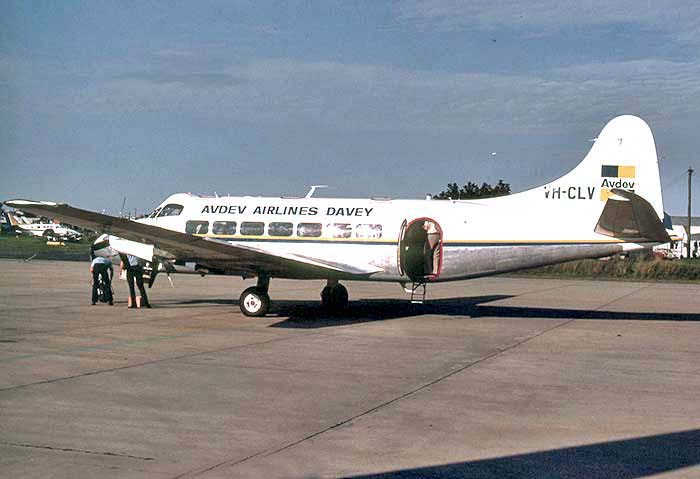
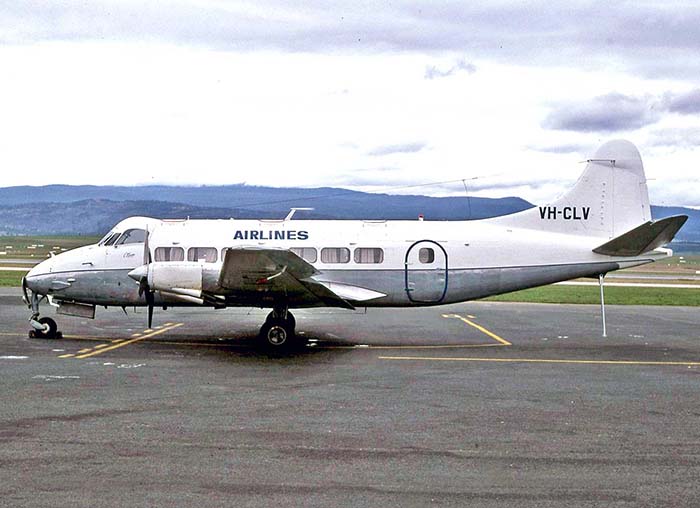

Photo by Mike Madden

VH-CLV in storage at the Queen Victoria Museum, Launceston but no longer wanted in 2021.
Photo: Aviation Historical Society of Tasmania
Photo: Aviation Historical Society of Tasmania
| .56 | Built by De Havilland Aircraft Co Ltd, Hawarden Aerodrome, Chester. Production Heron 2D |
| 12.56 | Test flown with Class B registration G-5-15 |
| .56 | Sold to West German Air Force/Luftwaffe as CA+001 |
| Luftwaffe acquired two new Herons for military communications including personal transport of Chief of Staff and Chancellor Conrad Adenauer. They were the first British built aircraft to serve in the post-war Luftwaffe which was largely US backed. Both these Herons were to later come to Australia for Connair. | |
| 31.1.57 | Departed Chester on delivery flight, overnight Southend. Next day flew to Koln-Bonn. |
| 13.2.57 | Luftwaffe operating permit issued. On strength 3./LTG62 (VIP) Squadron |
| 7.1.63 | Ferried West Germany to Sywell, England on delivery to Shackleton Aviation |
| 4.3.63 | Registered G-ASFI Shackleton Aviation Ltd, London (Aircraft brokers) |
| 28.5.63 | British CofA issued, based Sywell |
| 11.63 | Sold to USA, registration N4661T allocated but sale not completed. Remained at Sywell as G-ASFI |
| 15.9.64 | Registered CR-GAT Transportes Aereos de Guinea Portuguesa - TAGP, Bissau, Portuguese Guinea |
| 5.70 | Sold to Connellan Airways, Australia |
| 21.7.70 | Registered VH-CLW Connellan Airways Ltd, Alice Springs NT |
| 21.8.70 | Arrived Alice Springs on delivery flight |
| 3.72 | Rebuilt at Alice Springs by Connair as Riley Heron with four Lycoming IO-540 engines, 3 bladed props |
| 13.4.72 | Test flight Alice Springs after Riley conversion |
| 17.4.72 | Civil register type changed to DH.114 Heron 2D/A1 |
| .76 | Leased to Kendell Airlines, Wagga NSW |
| 6.76 | noted
at Sydney Airport in Kendell Airlines red/black scheme operating a
scheduled Kendell service from Wagga. Noted Melbourne Airport 11.76 on
Kendell services. |
| 16.2.77 | Change of ownership: Premiair Aviation Pty Ltd, Wagga NSW trading as Kendell Airlines. Managing Director Don Kendell |
| 21.7.79 | Struck-off Register during a major overhaul at Wagga during which the wing structural life was extended by use of a wing strap modification rather than replacing the wing spar. |
| 10.3.80 | Restored to Civil Register |
| 3-5.80 | Leased to Executive Airlines, Melbourne-Essendon Vic. |
| 5.80 | noted at Melbourne Airport back in Kendell Airlines markings, on scheduled Kendell services. Kendell's Herons VH-CLW and VH-KAM were being replaced by Swearingen Metros. |
| 5.81 | Sold to Air Tungaru, Tarawa, Kirabati (formerly Gilbert and Ellis Islands) |
| 30.5.81 | VH-CLW
departed Wagga for Brisbane on delivery flight painted in Air Tungaru
markings. Delivery pilots were Don Kendell and John Macknight (of Macknight Airlines, Deniliquin NSW). The previous night a hangar party was held, with everyone associated with the Kendell Airlines Heron era invited. |
| 1.6.81 | Arrived Tarawa on delivery via Brisbane, Noumea, Nadi, Funafuti. Don Kendell gave endorsement training to Air Tungaru pilots. |
| 26.6.81 | Registered T3-ATA Air Tungaru, Tarawa, Kirabati |
| 11.84 | Ferried Tarawa-Fiji on sale to Sunflower Airlines |
| 3.12.84 | Registered DQ-FDY Sunflower Airlines, Nadi, Fiji. Named Belo Vula (white heron) |
| 1.85 | Port
wing seriously damaged when Nadi hangar was wrecked during a
cyclone. Repaired using a replacement wing acquired from Prinair,
Puerto Rico and airfreighted to Fiji by Flying Tiger Line. Because the hangar had been demolished, the replacement wing was fitted in the open weather. |
| 21.8.88 | Damaged by fire during refuelling, Nadi Airport Fiji |
| 7.95 | Sold to Heron Airlines, Sydney NSW |
| 15.4.97 | DQ-FDY departed Nadi for Noumea on delivery flight to Sydney |
| 97-00 | DQ-FDY parked at Sydney-Bankstown, stripped for parts. |
| 9.00 | Acquired by Paul Ewoldt, Sydney on loan to Australian Aviation Museum, Bankstown Airport |
| 12.2.01 | DQ-FDY noted at Bankstown, less engines and parts |
| 09 | Reported to be loaned by Paul Ewold to Mudgee Aero Club for a planned aviation museum at Mudgee |
| .12 | Sold dismantled by Ewold to Central Australian Aviation Museum, Alice Springs NT |
| Moved to Alice Springs where assembled and restored for display at
CAAM by volunteers, including retired former Connair Heron pilots and engineers. | |
| Current. Displayed at CAAM as yellow Connair VH-CLW |
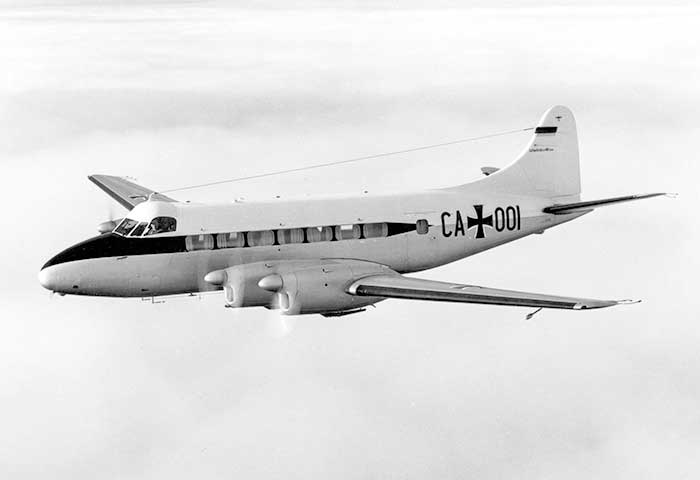
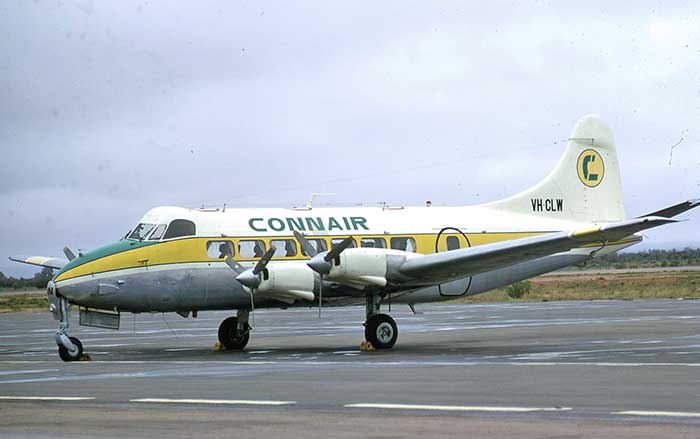
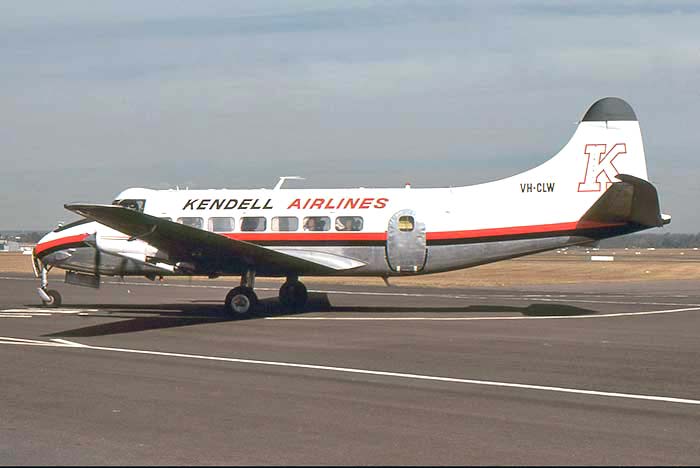
incorporate an airstair design. Photo by David Carter
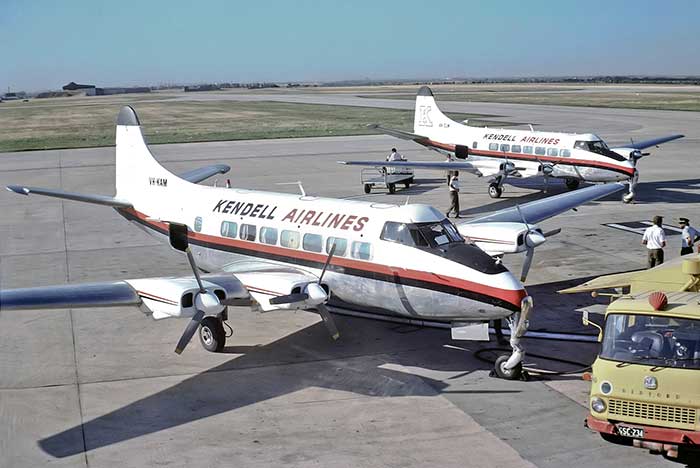
Civil Aviation Historical Society/Mike O'Grady collection
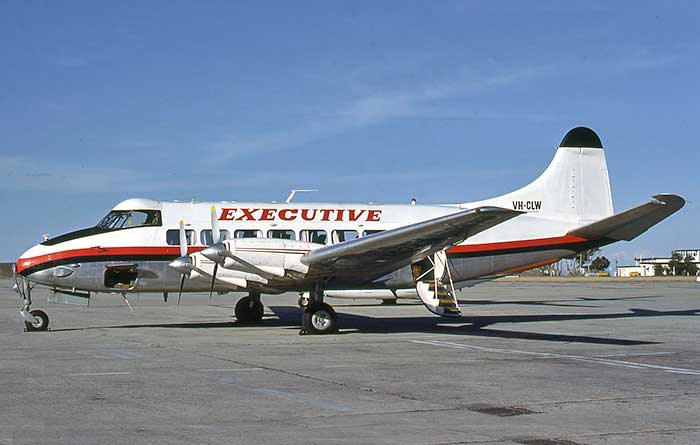
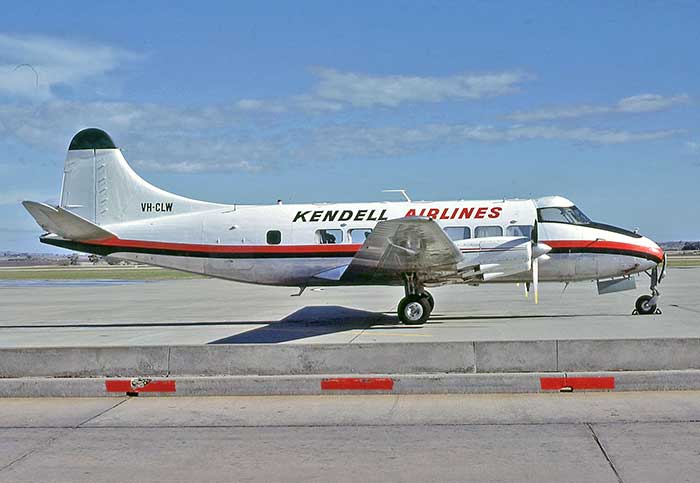

Photo by Ron Cuskelly
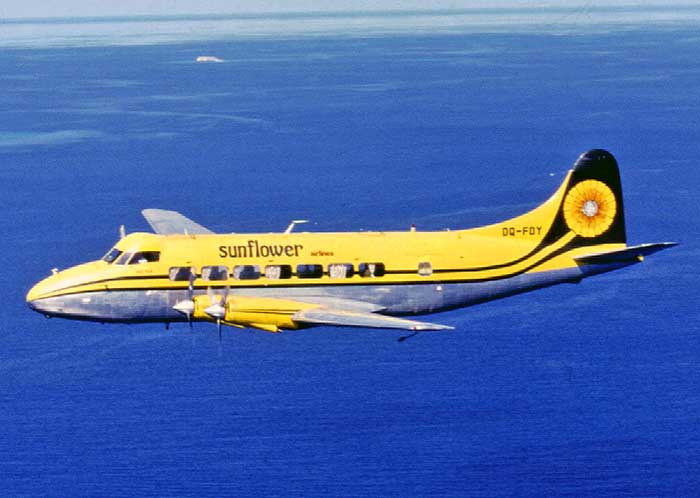

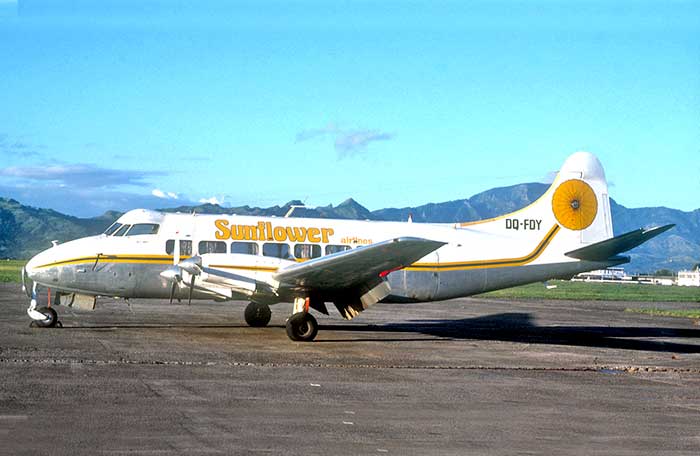
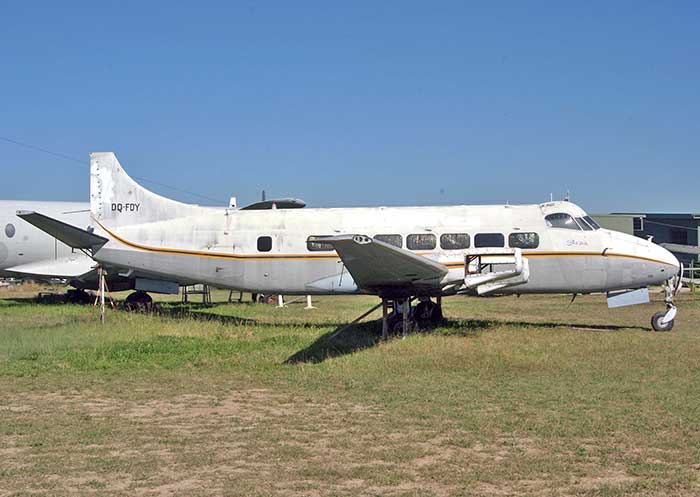

Photographed there nearing completion in August 2017 by Ian McDonell
| .56 | Built by De Havilland Aircraft Co Ltd, Hawarden Aerodrome, Chester. Production Heron 2D |
| 20.11.56 | Registered G-ANPV De Havilland Engine Company, Leavesden Aerodrome Hertshire |
| 1.57 | First flight, test flown with Class B registration G-5-24 |
| Stored 57-59 pending sale | |
| 31.10.59 | Change of ownership: Tube Investments (Group Services) Ltd, Birmingham |
| 18.1.60 | British CofA issued |
| 26.11.70 | Change of ownership: Dismore Aviation Ltd, London |
| 22.12.70 | Sold to Connair Pty Ltd, Alice Springs |
| Ferried to Australia | |
| 12.3.71 | Registered VH-CLX Connair Pty Ltd, Alice Springs NT |
| 1.72 | Rebuilt at Alice Springs by Connair as Riley Heron 2 with four Lycoming IO-540 engines, 3 bladed props |
| 10.2.72 | Civil register type changed to DH.114 Heron 2D/A1 |
| 1.11.73 | Damaged, heavy landing Alice Springs |
| 26.12.74 | Flew
Alice Springs-Tennant Creek-Darwin arriving just after dawn to support the
evacuation of Darwin citizens following the devastation of Cyclone Tracy the previous day. Urgently needed Police equipment was loaded at Tennant Creek. Captain Bob Forman, F/O Bob Brown. |
| 14.3.80 | Eddie Connellan sold Connair and its assets to East West Airlines, Tamworth NSW. East West formed a new operation Northern Airlines to take over the Connair routes |
| 18.6.80 | Change of ownership: Northern Airlines Pty Ltd, Darwin NT Not put into service, retained Connair paint scheme |
| 6.2.81 | Northern Airlines ceased operations. Parked at Alice Springs with other Northern Herons pending disposal |
| 7.7.83 | Change of ownership: Airlines of Tasmania Pty Ltd, Launceston Tasmania. Named Nammo |
| 9.7.83 | Delivered to Launceston still in Connair paint scheme |
| Originally acquired by Airlines of Tasmania for spare parts because of its high wing hours. After VH-CLY's landing accident at Launceston 4.8.83, the company decided to put CLX into service fitted with the repaired mainplane of CLY. | |
| Airlines of Tasmania named their rebuilt VH-CLX Nammo in recognition of Connair ground engineer Ian "Nammo"Bradman whose actions in securing Connair Heron VH-CLT at Darwin on the night of Cyclone Tracy saved that aircraft. | |
| 16.10.85 | Total flying time 14,963 hours |
| 6.93 | Airlines of Tasmania report: VH-CLV and VH-CLX are the only Herons remaining in service, while VH-KAM is on lease in New Zealand |
| 2.95 | retired Launceston |
| - | Reportedly sold to Heron Airlines, Sydney. Assumed for engines and parts only. |
| 14.2.97 | Airlines of Tasmania ceased operations. |
| 13.8.97 | Sold to Australia Pacific Air Parts, Burleigh Gardens Queensland. Stripped for parts at Launceston |
| .01 | Stripped airframe acquired by Australian National Aviation Museum, Moorabbin Airport, Melbourne |
| 21.6.01 | Dismantling commenced at Launceston by a team from NAAM |
| 25.6.01 | Arrived at ANAM Moorabbin by truck from Launceston via boat ferry from Tasmania |
| Assembled and restored for display in faded Airlines of Tasmania paintwork. Fitted with cowlings but no Lycoming engines, tailplane stored under cover on site | |
| 5.16 | Offered for sale "as is" by ANAM |
| Sold to Historical Aircraft Restoration Society, Parks Airport NSW HARS based at Albion Park, Wollongong NSW was developing a second site at Parkes for its growing collection of airworthy and static display aircraft. | |
| 2.9.16 | VH-CLX departed Moorabbin by road for Parkes |
| Current. Static display at HARS Parkes |
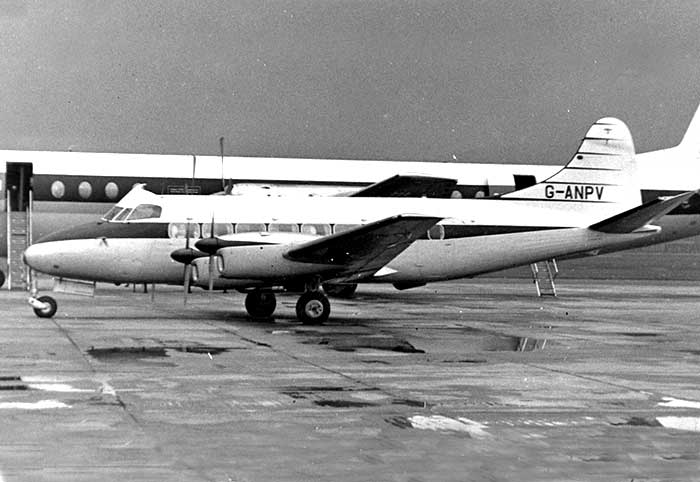

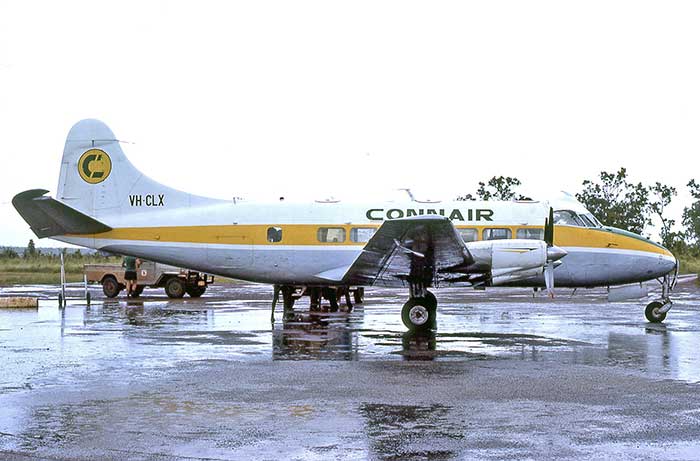
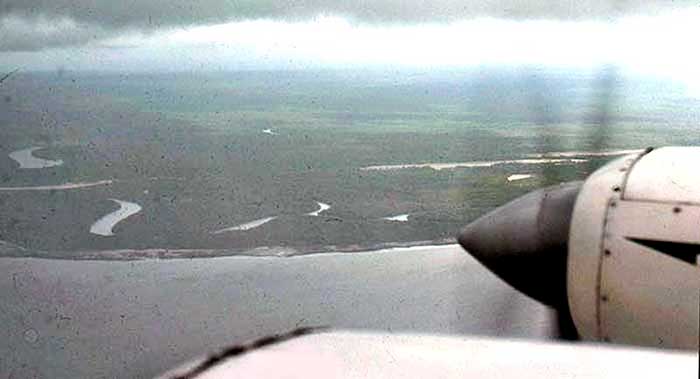
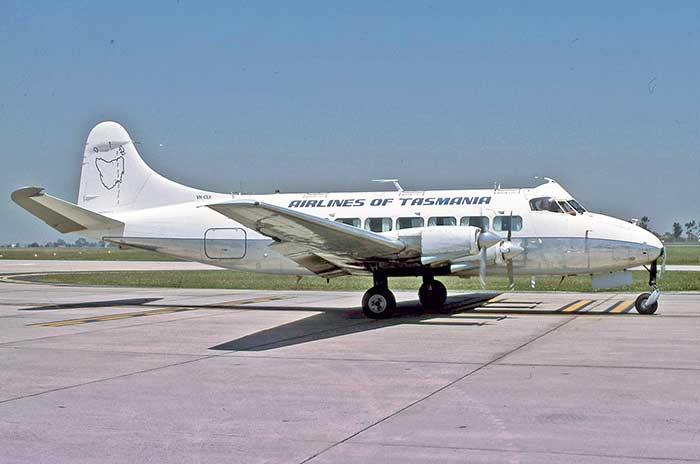
Photo by Mike Madden
| .50 | Built by De Havilland Aircraft Co Ltd, Hatfield Aerodrome. Prototype DH.114 Construction used a DH.104 Dove nose and tail units joined by a lengthened Dove keel, roof and side members, and Dove outer wing panels. Four 250hp DH Gipsy Queen 30 engines with two baded props |
| 30.3.50 | Registered G-ALZL De Havilland Aircraft Co Ltd, Hatfield |
| 10.5.50 | First test flight Hatfield, flown by DH test pilot Geoffrey Pike. Aircraft in polished metallic finish |
| Airframe Log book: extensive test flying and certification trials, 180 hours | |
| 20.6.50 | Airframe Log book: test flight after modifications by DH Leavesden |
| 20.11.50 | British CofA issued. 2 pilots and 14 passengers. 3 extra passenger seats approved if the rear cabin toilet was removed |
| 24.11.50 | Departed Hatfield for Africa for tropical performance trials at Khartoum and Nairobi |
| 20.12.50 | Airframe Log book: total
time 260 hrs. Sent to DH plant at Leavesden Aerodrome for modifications
including a dihedral tailplane and redesigned cockpit canopy. Test
flown 14.2.51 after mods by Geoffrey Pike |
| 51 | Trial
installation of more powerful 330hp DH Gipsy Queen 30-3 engines, but
refitted with the original model 250hp Gipsy Queen 30s |
| 5.51 | Handed over to DH Sales Department for demonstration to potential customers |
| 8.51 | Painted
in British European Airways Corp paint scheme for evaluation on
Northolt-Channel Islands services. mOver five successive weekends
G-ALZL carried a total of 5,000 passengers |
| 52 | Painted in Morton Air Service scheme for demonstrations to the airline based London-Croydon |
| .52 | Early 1952 demonstrated at Oslo, Norway to airline Braathens SAFE |
| 7.52 | Demonstrated at Farnborough Air Show, painted in Japan Airlines scheme |
| 25.4.54 | Registered LN-BDH Braathens SAFE Air Transport, Oslo, Norway. One month lease from DH. Airline founded by Ludvig G. Braathen, owner of the Braathens South America and Far East shipping line, which operated DC-3s and DC-4s. Two Herons were purchased in 1952. |
| 14.5.54 | Returned to DH from Norway |
| 21.5.54 | Registered G-ALZL De Havilland Aircraft Co Ltd, Hatfield |
| 15.12.54 | Airframe Log book: total time 842 hrs. Brought up to production standard Heron Mk.1B. |
| 30.6.55 | Change of ownership: Jersey Airlines, Jersey Airport, Channel Islands. Named Duchess of Paris Jersey Airlines was the first British Airline to introduce Herons on its services between the Chanel Islands, France and England. G-ALZL was their 7th and last delivered in July 1955. |
| During summer peak seasons, Jersey Airways removed the rear cabin toilet of its Herons to allow 17 pax. | |
| 12.2.59 | Change of ownership: Alares Development Co, Jersey Airport (Parent company of Jersey Airlines) |
| 15.12.59 | Airframe Log book: total time 6,049 hrs. |
| 26.2.62 | Airframe Log book: total time 8,653hrs. |
| 9.10.62 | Change of ownership: Executive Air Transport Ltd, Birmingham. EAT was established 9.60 as aircraft leasing specialists, with or without crews, also providing Dove and Heron support and maintenance. EAT owned a total of 12 Herons for leasingout. |
| 8.5.64 | G-ALZL commenced a 12 month lease to English Electric Co Ltd, Samlesbury. Used as a executive transport between factories |
| 2.6.65 | Returned to Executive Air Transport Co |
| 8.65 | Leased to Emerald Airways Ltd, Belfast, Northern Ireland. Established in January 1965 to fly passenger services within Ireland and to Scotland. Began with four leased Herons and later Short Skyvans and DC-3s. Ceased operations November 1967. |
| 3.9.65 | G-ALZL operated Emerald Airways' inaugural services |
| 11.66 | Returned to Executive Air Transport Co |
| 2.12.66 | Sold to Dan-Fly, Denmark |
| 13.12.66 | Registered OY-DGS Dan-Fly, Copenhagen, Denmark |
| .68 | Sold to Cimber Air, Copenhagen, Denmark |
| 26.9.69 | Change of ownership: Geoplan Company, Copenhagen Aerial survey operations, crewed and maintained by Cimber Air. |
| .73 | Sold to Altair Pty Ltd, Perth, Western Australia. |
| 29.7.73 | OY-DGS arrived Perth-Jandakot on delivery from Denmark. "Geoplan" markings |
| 6.8.73 | Struck-off Danish Register |
| 23.8.73 | Registered VH-CJS Altair Pty Ltd, Jandakot Airport, Perth, Western Australia. |
| 23.8.73 | Australian CofA issued after overhaul at Jandakot. That day flew pilot-training circuits at Perth Airport |
| 8.73 | Entered
Altair service carrying staff and equipment on contract to WA Petroleum
Company to oil and gas fields at Barrow Island and further north in
Western Australia. Also operated by Altair on the WAPET contract and
other mining support were DH.104 Devons VH-CJX, VH-CJY and Mitsubishi
Mu-2G VH-CJP. Later
Altairused 3 leased Cessna
500 Citations on drilling support contracts between Perth, Timor and Broome. |
| 10.74 | Altair Pty Ltd ceased operations. |
| 23.10.74 | VH-CJS was ferried Telfer mine-Meekatharra-Jandakot after collapse of Altair. Parked Jandakot. |
| 8.1.75 | Change of ownership: Lease Industrial Finance Ltd, Sydney NSW |
| 1.75 | Altair Heron and Devons sold to Ernst van Reesma, Adelaide SA trading as Armor Coatings (Australasia) Pty Ltd. He had a financial interest in Adelaide air service Coveair Pty Ltd. |
| 25.1.75 | VH-CJS arrived Adelaide on delivery ex storage Jandakot. Operated on Coveair's charter licence |
| 26.1.75 | Flew an Adelaide-Whyalla charter |
| 24.2.75 | Civil Register Change of ownership: Armor Coatings (Australasia) Pty Ltd, Adelaide SA |
| Based
Adelaide Airport, flew charters and on Coveair's scheduled passenger
services to Kangaroo Island and SA towns. "Coveair" painted above
windows. | |
| 26.8.75 | Rolled out at Parafield after repaint in a new Coveair white and red paint scheme |
| 12.75 | Leased by Armor Coatings to Amalgamated Air Services, Jandakot Airport, Perth The lease included Devons VH-CJY and VH-MGT which were also ferried to Perth from Adelaide |
| Amalgamated Air Services was a short-lived business recently formed by Managing Director Michael D. Rainsford, Perth. AAS took over the lease of Heron CJS and Doves VH-CJY & MGT for a contract to carry mining workers and equipment from Perth to the gold mine operation at Telfer in the Gibson Desert, 1300 Km north. | |
| Michael Rainsford recalled "I negotiated for Amalgamated Air to lease the Heron from Armor Coatings. We then flew CJS from Adelaide to Perth to operate it on a contract run from there to Telfer on a two or three times a week return passenger and freight service. The Heron flew this for about ten months (stet), clocking up 80,000 miles in ground temperatures of up to 50 degrees Celsius. It was retired when servicing and parts costs became prohibitive and an unsatisfactory agreement experienced between the owners Armor Coating and Amalgamated Air. " | |
| 4.12.75 | VH-CJS arrived Perth-Jandakot on delivery from Adelaide |
| 28.3.76 | VH-CJS flew a freight charter Perth-Adelaide during an Ansett and TAA airline pilot strike |
| 10.5.76 | Change of ownership: Michael D. Rainsford, Perth WA (Managing Director Amalgamated Air Services) |
| 21.5.76 | Heron VH-CJS last flight. Perth Airport-Jandakot ferry on three engines |
| 8.76 | Amalgamated Air Services ceased operations |
| VH-CJS parked in open
weather at Jandakot while lengthy legal action took place in an attempt
to recover monies owed between Armour Coatings, Coveair, United Air
Services, Amalgamated Air Services and several finance companies. | |
| 10.9.76 | Struck-off Civil Register |
| c86 | VH-CJS and Devon VH-CJY acquired by West Australian Museum of Aviation, Perth. WAMA was formed by a group of enthusiasts including aircraft ground engineers with plans for a new museum in Perth with different objectives to the existing WA Aviation Heritage Museum at the Airforce Association estate Bull Creek, Perth |
| 86 | VH-CJS and VH-CJY stored dismantled in a vehicle compound at Jandakot Airport, Both are in poor condition after 10 years weather exposure. Stored with ex RAAF Canberra A84-207 and DC-3 PK-GDC "Broome Tourist Bureau".until 1988 when airport management needed the compound area for development |
| 1.88 | VH-CJS was moved by truck from the compound to another site on the airport |
| West Australian Museum of Aviation project was abandoned. Its aircraft collection was dispersed | |
| 28.1.97 | The Heron was moved by road to Aviation Heritage Museum of WA, Bull Creek, Perth |
| Held
dismantled at AHM. Major airframe sections were restored and
Gipsy Queen engines brought up to display standard, before the decision
was made to cease work and place it up for sale. | |
| .11 | Sold to International Airliners Museum, Victoria |
| 25.10.11 | VH-CJS fuselage noted outside at Aviation Heritage Museum, Heron due to be transported to Victoria |
| 2.12.11 | Departed Bull Creek by road for Victoria |
| Stored dismantled by founder of the embryo International Airliners Museum | |
| .13 | Acquired by Australian National Aviation Museum, Moorabbin Airport, Melbourne Vic |
| 19 | Stored dismantled in museum compound Moorabbin, long-term restoration project |
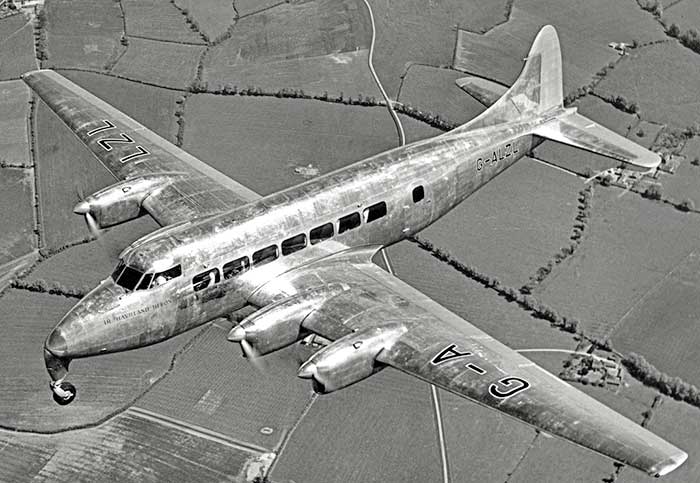
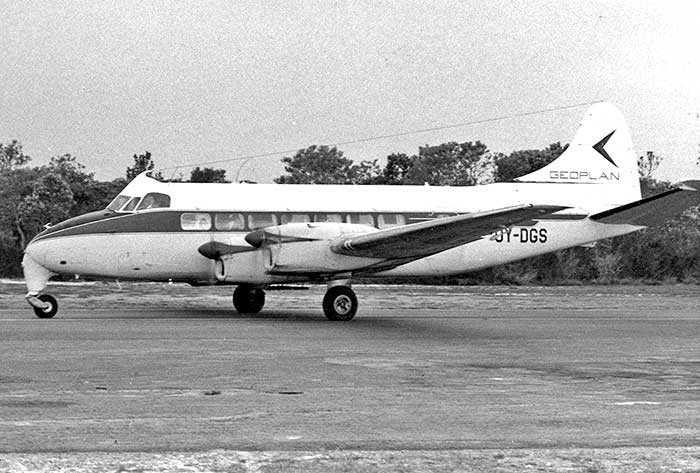
Both photos Geoff Goodall collection

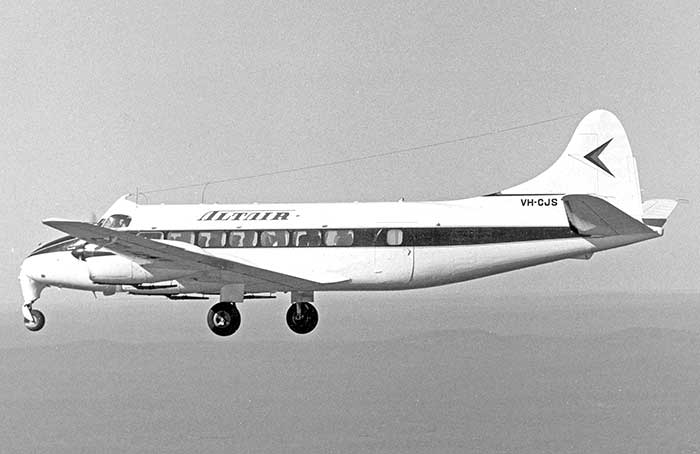
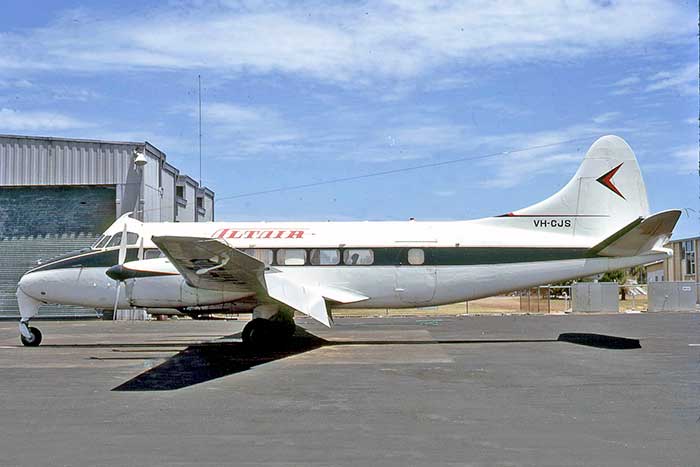
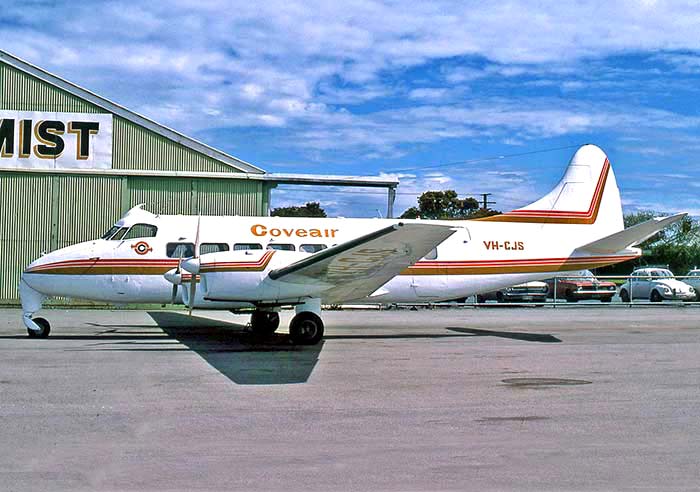
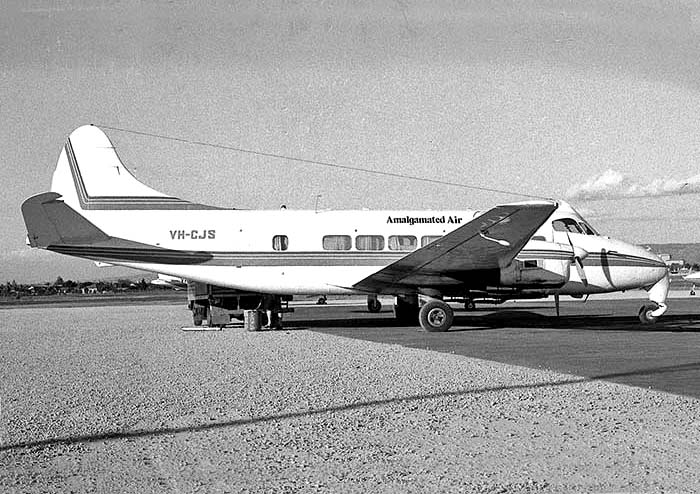
Photo by Geoff Goodall
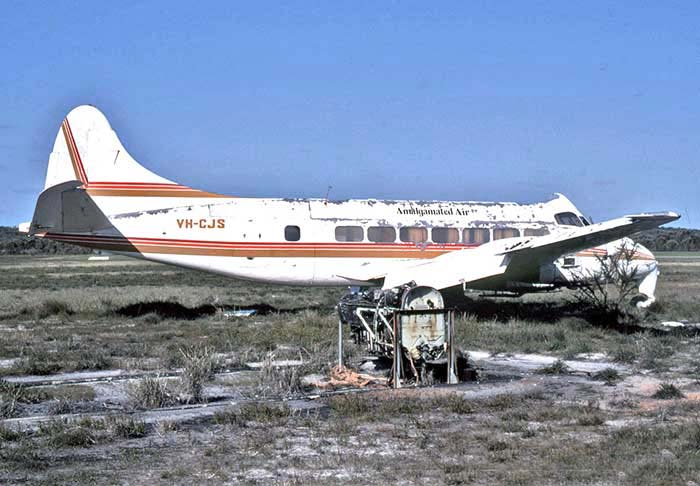
Photo by Geoff Goodall
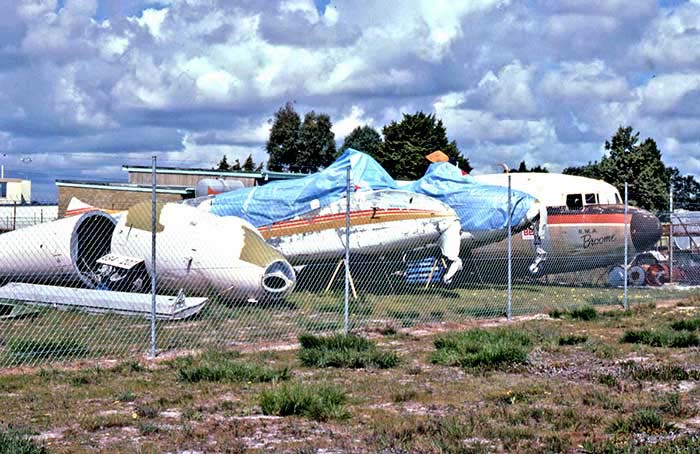
Photo by Geoff Goodall
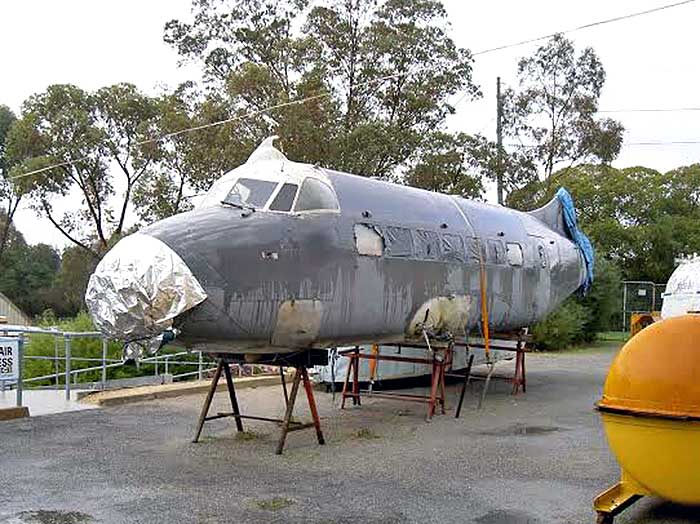
Photo by Joe Barr
| .57 | Built by De Havilland Aircraft Co Ltd, Hawarden Aerodrome, Chester. Production Heron 2D |
| 15.8.57 | Registered EC-AOC Aviacion y Comercio S.A. - AVIACO, Madrid Spanish independent airline which flew 8 Herons on high-frequency local services, main route Balbao-Madrid-Barcelona. Grew to become a major jet airline. |
| 31.7.64 | Registered G-ASVB Morton Air Services Ltd, London-Gatwick Airport (sales agents) |
| G-ASVB delivered to Gatwick from Spain, parked pending resale | |
| 1.10.64 | Registered VQ-FAE Fiji Airways Ltd, Suva, Fiji |
| 16.11.64 | VQ-FAE & VQ-FAF departed Gatwick on delivery flight to Fiji |
| 4.71 | Change of operating name Air Pacific, Suva, Fiji |
| 1.10.71 | Reregistered DQ-FAE Air Pacific, Suva, Fiji |
| 4.75 | Connair sent Assistant General Manager
Stephen Marshall and Engineering Manager Bob Bovill to Fiji to
negotiate the purchase of Herons DQ-FAC, DQ-FAE and DQ-FAF retired with time-expired wing spars. A representative from Prinair, Puerto Rico (then the world's biggest Heron operator) was also in Fiji to acquire the same trio, but Connair was successful: three Herons plus spare parts for $50,000. Fiji aviation authorities approved ferry flights to Australia on a crew-only basis. |
| 4.75 | Sold to Connair Pty Ltd, Alice Springs NT |
| 26.7.75 | DQ-FAE noted at Brisbane Airport on ferry flight from Fiji to Alice Springs, full Air Pacific scheme. Continued Brisbane-Alice Springs 29.7.75. |
| 11.8.75 | Struck-off Fiji Register |
| Parked at Alice Springs with DQ-FAF pending overhaul and conversion to Riley Herons | |
| Rebuilt at Alice Springs by Connair as Riley Heron 2 with four Lycoming IO-540 engines, 3 bladed props | |
| 17.8.76 | Registered as DH.114 Heron 2D/A1 VH-CLY Connair Pty Ltd, Alice Springs NT |
| 14.3.80 | Eddie Connellan sold Connair and its assets to East West Airlines, Tamworth NSW. East West formed a new operation Northern Airlines to take over the Connair routes |
| 9.6.80 | Change of ownership: Northern Airlines Pty Ltd, Darwin NT |
| 6.2.81 | Northern Airlines ceased operations |
| Parked Darwin, later Alice Springs pending disposal with other Northern Airlines Herons | |
| 9.5.83 | Change of ownership: Airlines of Tasmania Pty Ltd, Launceston Tasmania |
| 9.5.83 | Delivery flight Alice Springs-Leigh Creek-Essendon-Launceston. |
| Entered service in Northern Airlines scheme with "Airlines of Tasmania" painted above windows | |
| 4.8.83 | Crashed during landing Launceston Tas. When misligned with the runway on the landing approach, the Pilot in Command made a late go-around, the flaps were partially raised and the landing gear was retracted. The aircraft sank and left wing struck several fences before the aircraft slid to a halt on its belly. 2 crew and 5 passengers were not injured |
| Damage assessed as beyond economical repair, dismantled for parts | |
| Mainplane of VH-CLY fitted to VH-CLX. | |
| Stripped fuselage sold as scrap | |
| 02 | Fuselage on a farm at Evanston Tas. Later the nose section was cut off and the remainder removed as scrap |
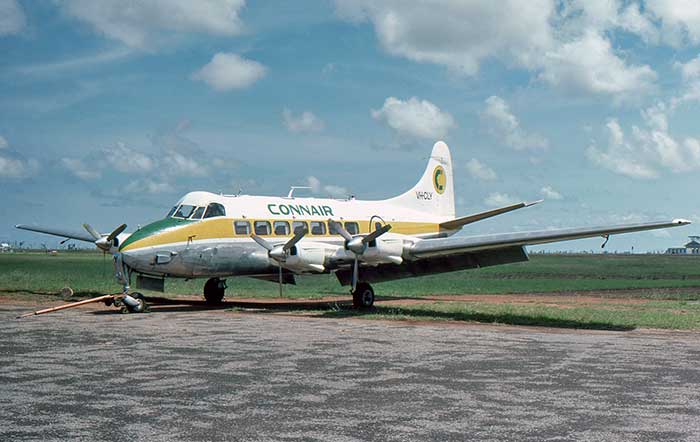

| .55 | Built by De Havilland Aircraft Co Ltd, Hawarden Aerodrome, Chester. Production Heron 2 |
| 8.55 | Registered VT-DHJ Indian Airlines Corporation |
| .58 | Sold to Hindustan Steel Company |
| 5.62 | Sold to Indamer Co (aircraft dealers) |
| 12.62 | Registered VQ-FAC Fiji Airways Ltd, Suva, Fiji |
| 21.6.64 | VQ-FAC arrived Sydney-Bankstown for overhaul, reportedly en route from India to Fiji |
| 4.71 | Change of operating name Air Pacific, Suva, Fiji |
| 1.10.71 | Reregistered DQ-FAC Air Pacific, Suva, Fiji |
| 4.75 | Connair sent Assistant General Manager
Stephen Marshall and Engineering Manager Bob Bovill to Fiji to
negotiate the purchase of Herons DQ-FAC, DQ-FAE and DQ-FAF retired with time-expired wing spars. A representative from Prinair, Puerto Rico (then the world's biggest Heron operator) was also in Fiji to acquire the same trio, but Connair was successful: three Herons plus spare parts for $50,000. Fiji aviation authorities approved ferry flights to Australia on a crew-only basis. |
| 4.75 | Sold to Connair Pty Ltd, Alice Springs NT |
| 12.6.75 | DQ-FAC arrived Alice Springs from Fiji on delivery flight, Air Pacific scheme |
| Australian certification overhaul and conversion to Riley Heron carried out by Connair at Alice Springs | |
| 19.4.77 | Registered VH-CLZ as DH.114 Riley Heron 2E/A1: Connair Pty Ltd, Alice Springs NT |
| 14.3.80 | Eddie Connellan sold Connair and its assets to East West Airlines, Tamworth NSW. East West formed a new operation Northern Airlines to take over the Connair routes |
| 18.6.80 | Change of ownership: Northern Airlines Pty Ltd, Darwin NT |
| 6.2.81 | Northern Airlines ceased operations |
| 81-83 | Parked Alice Springs pending disposal with other Northern Herons |
| 25.5.83 | Sold to Airlines of Tasmania Pty Ltd, Launceston |
| 4.7.83 | Delivered Alice Springs-Leigh Creek-Essendon-Launceston, still in Northern Airlines paint scheme |
| 21.10.83 | Civil Register change of ownership: Airlines of Tasmania Pty Ltd, Launceston Tasmania Named Spirit of Tasmania |
| 16.10.85 | Total flying time 21,068 hours |
| .89 | Retired at Launceston. |
| 11.89 | noted Launceston parked outside, airline markings painted over, one engine removed. |
| 5.91 | stripped airframe in poor condition outside Airlines of Tasmania hangar Launbeston |
| 14.2.97 | Airlines of Tasmania ceased operations |
| 29.9.97 | Struck-off Civil Register |
| 22.7.98 | Sold to Heron Airlines, Sydney NSW: stripped for parts |
| by 01 | Stripped airframe donated to Queen Victoria Museum and Art Gallery, Launceston Tasmania Museum planned to use parts of CLZ to complete the more complete VH-CLV for display. |

Photo by Gordon Clear via SA Aviation Museum

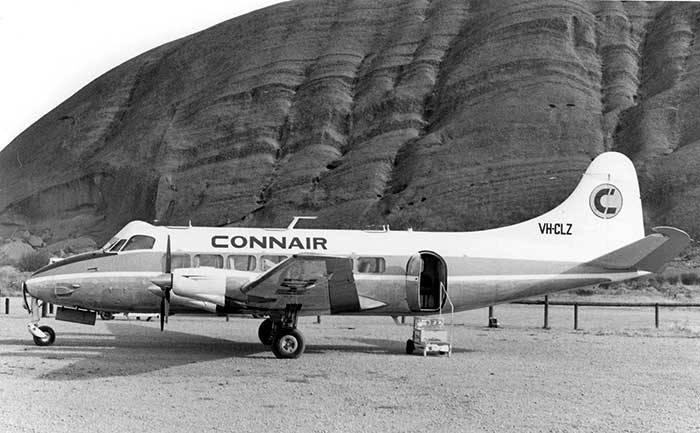


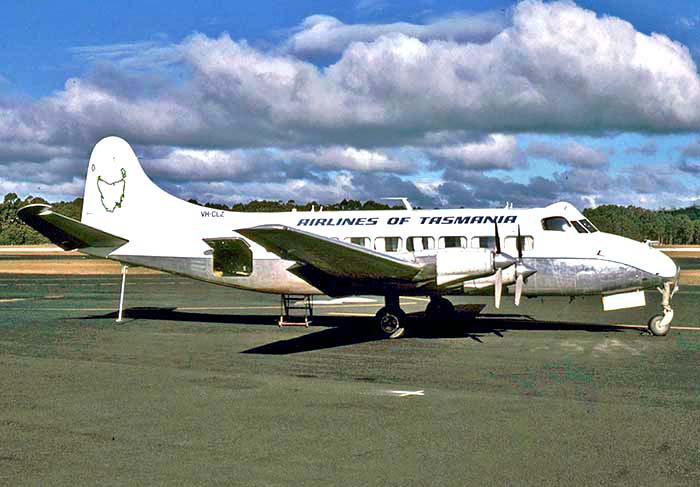
Photos by Geoff Goodall
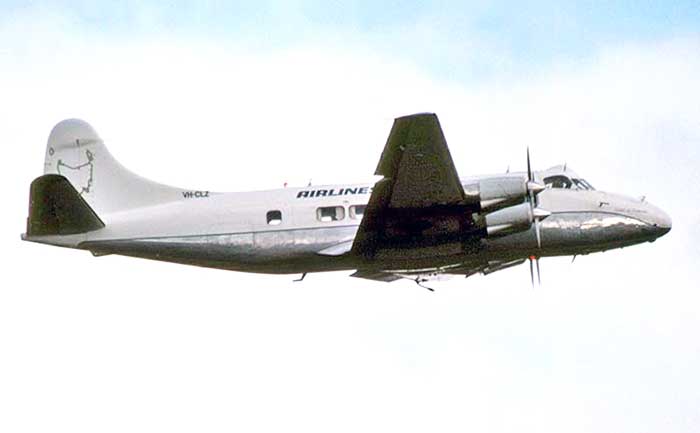

| .57 | Built by De Havilland Aircraft Co Ltd, Hawarden Aerodrome, Chester. Production Heron 2D |
| 2.10.57 | Registered EC-AOF Aviacion y Comercio S.A. - AVIACO, Madrid Spanish independent airline which flew 8 Herons on high-frequency local services, main route Balbao-Madrid-Barcelona. Grew to become a major jet airline. |
| 2.10.57 | Aircraft log book: EC-AOF delivered England to Spain, 7 hr 5 mins |
| 31.7.64 | Registered G-ASVC Morton Air Services Ltd, London-Gatwick Airport (sales agents) |
| 20.8.64 | G-ASVC arrived Gatwick on delivery from Spain |
| 1.10.64 | Registered VQ-FAF Fiji Airways Ltd, Suva, Fiji |
| 16.11.64 | VQ-FAF and VQ-FAE departed Gatwick on delivery flight to Fiji |
| 26.2.65 | VQ-FAF arrived Sydney-Bankstown for major overhaul by Hawker de Havilland. Departed Bankstown 15.4.65 on delivery to Fiji. |
| 4.71 | Change of operating name Air Pacific, Suva, Fiji |
| 1.10.71 | Reregistered DQ-FAF Air Pacific, Suva, Fiji |
| 4.75 | Connair
sent Assistant General Manager Stephen Marshall and Engineering Manager
Bob Bovill to Fiji to negotiate the purchase of Herons DQ-FAC, DQ-FAE and DQ-FAF retired with time-expired wing spars. A representative from Prinair, Puerto Rico (then the world's biggest Heron operator) was also in Fiji to acquire the same trio, but Connair was successful: three Herons plus spare parts for $50,000. Fiji aviation authorities approved ferry flights to Australia on a crew-only basis. |
| 4.75 | Sold to Connair Pty Ltd, Alice Springs NT |
| 14.5.75 | DQ-FAF noted at Brisbane Airport on ferry flight from Fiji to Alice Springs, full Air Pacific scheme. Continued next day to Alice Springs. |
| 2.6.75 | Struck-off Fiji Register |
| 8.7.75 | noted
parked at Alice Springs with DQ-FAC, awaiting overhaul and conversion
to Riley Herons by Connair. DQ-FAF had been on-sold to Kendell Airlines, Wagga NSW, with Connair contracted to carry out the Riley conversion prior to delivery to Kendell. |
| 75 | Rebuilt at Alice Springs by Connair as Riley Heron with four Lycoming IO-540 engines, 3 bladed props |
| 16.12.75 | Registered as DH.114 Heron 2D/A1 VH-KAM Kendell Airlines, Wagga NSW |
| 12.75 | Delivered Alice Springs-Wagga still in Air Pacific paint scheme. On arrival at Wagga it was repainted in Kendell Airlines' red black and white scheme. |
| 1.76 | Entered
commercial service with Kendell Airlines early January 1976, initially
mainly on Wagga-Melbourne return services twice daily. Replaced in 1980 by Swearingen Metroliners. |
| 8.80 | Change of ownership: Davey Air Services, Dubbo NSW This Dubbo charter business was established by Bill Davey in 1963 and by now operated scheduled airline services between Sydney and Dubbo connecting with Nyngan, Bourke, Brewarrina, and Cobar. |
| 8.81 | Davey Air Services taken over by Avdev Airlines, Sydney. Operated as Avdev Airlines Davey |
| 15.1.82 | Change of owner's name: Aviation Developments (Operations) Pty Ltd trading as Avdev Airlines of Australia, Sydney NSW Managing Director was William A. Davey who had founded Davey Air Services at Dubbo NSW in 1962. Avdev used Herons VH-CLV and VH-KAM on their prime routes Sydney-Parkes and Sydney-Lord Howe Island, replacing Beech 200s and Bandeirantes which proved unsuitable for the LHI run. |
| 1.5.84 | Change of ownership: East Coast Airlines, Sydney NSW Remained in basic Avdev Airlines scheme, operated as a back-up aircraft to East Coast's commuter airline network in NSW |
| 15.3.85 | Change of ownership: Seaspan Pty Ltd, Sydney operating as Tongair, Tonga |
| 16.3.85 | VH-KAM departed Sydney on delivery to Tonga, painted in Tongair markings |
| 1.5.85 | Returned to Sydney, parked |
| 16.7.85 | Change of ownership: Airlines of Tasmania Pty Ltd, Launceston, Tasmania |
| 9.85 | Intended sale to Sunflower Airlines, Fiji was not completed. Allocated registration DQ-FEC not taken up. |
| 14.9.85 | Delivered Sydney to Launceston, still wearing Tongair markings |
| 16.10.85 | Total flying time 24,721 hours |
| 6.92 | Leased by Airlines of Tasmania to Vincent Aviation, Wellington NZ. Vincent Aviation had been formed the previous year by Peter Vincent, a former SAFE air freight pilot, to fly group charters. Began with Heron ZK-TAJ but it was grounded due airframe corrosion 4.92. VH-KAM was leased as a replacement. See ZK-TAJ below for further details |
| 26.6.92 | VH-KAM delivered to Wellington NZ to Vincent Aviation. For the period of the lease, the Lycoming engines were replaced by the four Lycomings removed from Vincent Aviation's grounded Riley Heron ZK-TAJ. |
| 21.8.92 | Inaugural flight to Chatham Islands where Vincent Aviation planned scheduled services, which did not eventuate |
| 17.7.93 | Visited Dunedin on a rugby supporters charter |
| 21.8.93 | Departed NZ on return to Airlines of Tasmania at end of lease. Airframe time: 26,885 hrs |
| 4.11.94 | Last flight: Launceston-Flinders Island-Launceston. Captain Kevin Swiggs. Airframe time: 29,999 hrs and 7 minutes. Retired at Launceston due reaching the 30,000 hour wing life. |
| 14.2.97 | Airlines of Tasmania ceased operations |
| 30.6.97 | Sold to Australia Pacific Air Parts, Burleigh Gardens Queensland. Stripped for parts at Launceston |
| .97 | Stripped airframe donated to Queen Victoria Museum and Art Gallery, Launceston Tasmania |
| 5.9.97 | Queen
Victoria Museum accepted a proposal from Queensand Air Museum to trade
VH-KAM's airframe for a radial engine display supplied by QAM |
| 8.2.98 | QAM
recovery crew arrived at Launceston to prepare the Heron for road
transport to Queensland via the Bass Strait boat ferry to Melbourne |
| 18.2.98 | Arrived dismantled by road at Queensland Air Museum, Caloundra Airport Qld |
| Currently
displayed at QAM. Reassembled, restored and repainted as "VH-KAM
Airlines of Tasmania" Displayed without Lycoming engines but with
engine cowlings and fabricated propellers. |
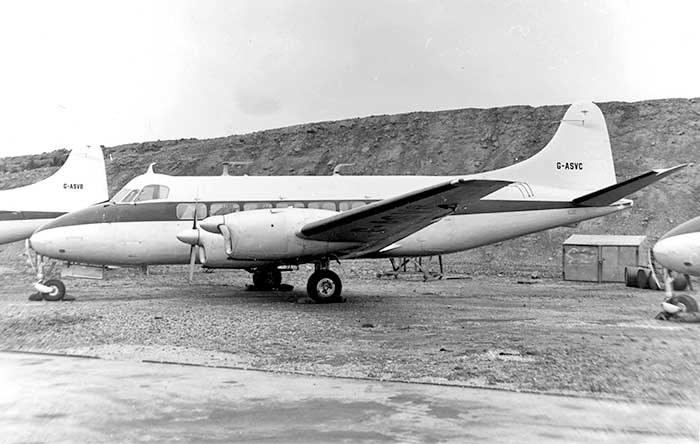
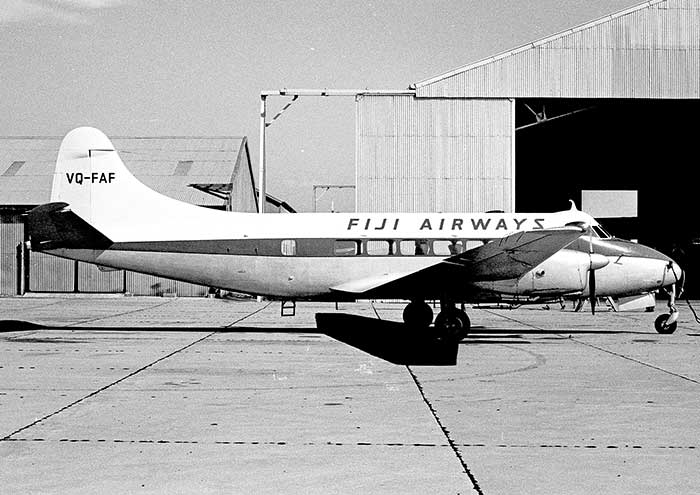
Photo by Bob Neate
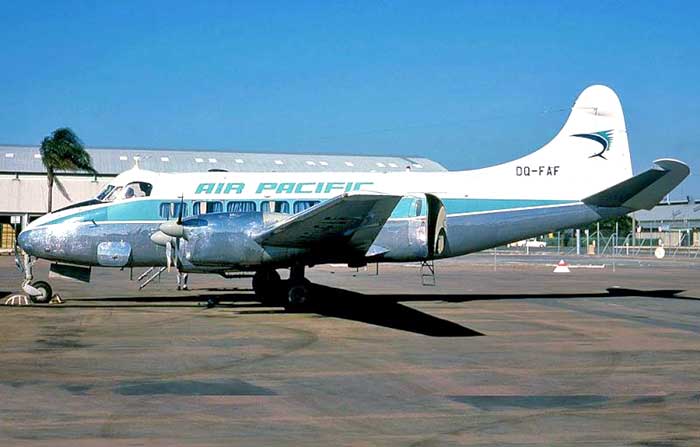
Photo by Peter Gates
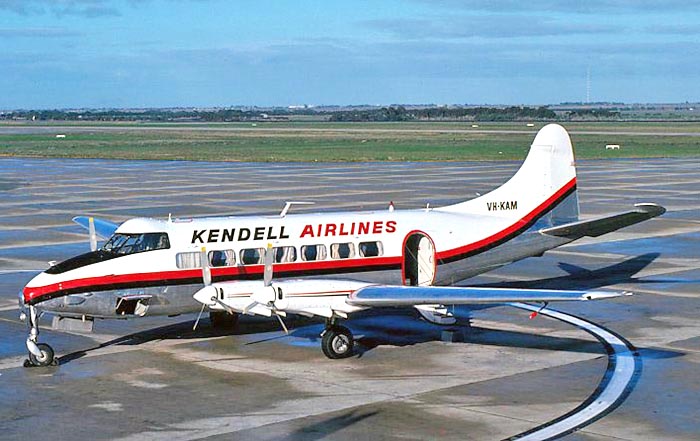

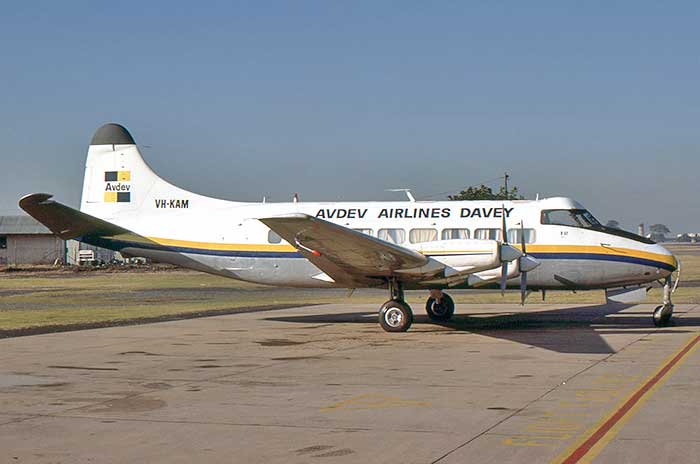
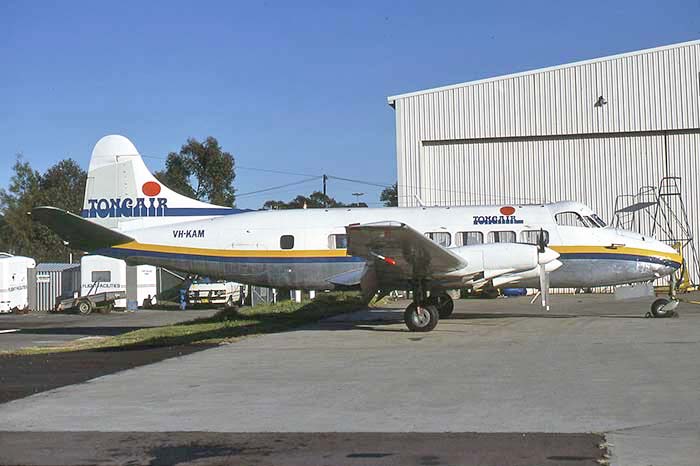
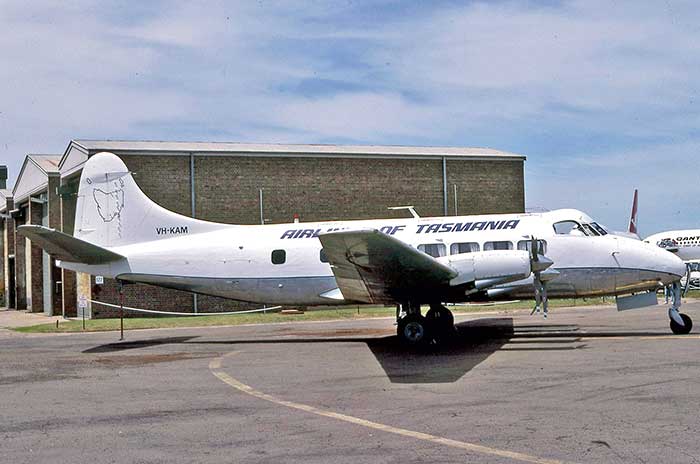
Next owner was Airlines of Tasmania. Seen at RAAF Richmond NSW October 1988 on a charter from Hobart.
Photo by Geoff Goodall
Photo by Geoff Goodall
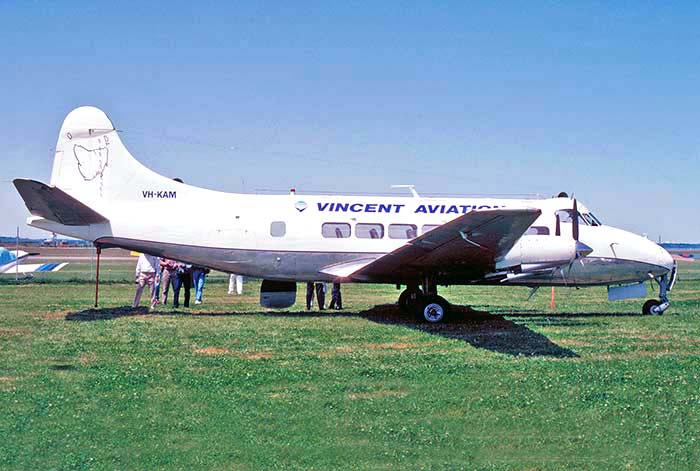
Photographed at Auckland Airport in November 1992 by Ron Cuskelly.
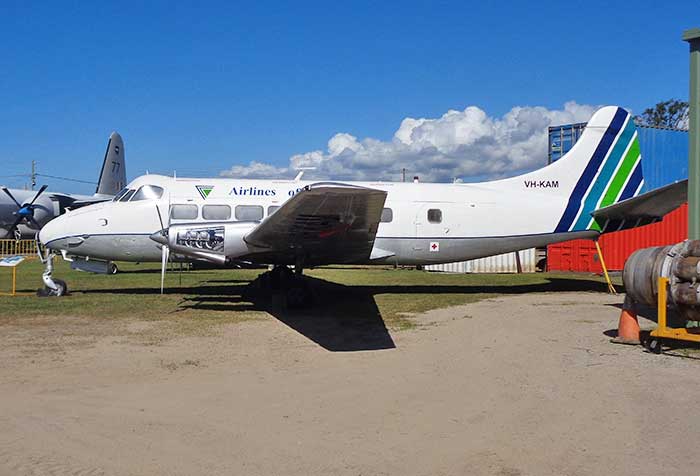
Queensland Air Museum's excellent restoration of VH-KAM's stripped airframe shell is painted in the final
scheme it wore with Airlines of Tasmania. Photographed at QAM in June 2019 by Angelo Calleja
scheme it wore with Airlines of Tasmania. Photographed at QAM in June 2019 by Angelo Calleja
| Built by De Havilland Aircraft Co Ltd, Hawarden Aerodrome, Chester. Production Heron 2D | |
| 15.2.55 | Registered TC-HER Daviet Hava Yollari, Istanbul, Turkey |
| 5.56 | Airline reorganised under new name Turk Hava Yollari - Turkish Airlines |
| 4.66 | Registered N484R Aviation Development Corp |
| 31.85.67 | Converted to Riley Heron with 4 Lycoming engines by Hayes Engineering on behalf of Riley Aeronautics Corpoation |
| 3.67 | Change of ownership: Heron Leasing Inc |
| 22.8.68 | Registered CF-RAB Royalair Ltd, Canada |
| 27.1.69 | Registered N138FA Bevdale Inc operating as Fleet Airlines |
| 5.71 | Registered N111KA Kundert Aviation |
| 2.72 | Registered N413SA Swift Aire Lines, San Luis Obispo, California |
| .76 | Change of ownership: United Medical Leasing |
| .77 | Registered N15FB Fischer Brothers Aviation, Gallion Ohio operating as Allegheny Commuter |
| 7.11.83 | Change of ownership: Short Brothers Ltd (trade-in on Shorts SD360s) |
| 21.1.84 | Change of ownership: Susquehanna Airlines, Binghamton New York |
| 1.85 | Susquehanna Airlines was grounded by FAA citing safety violations. |
| 12.85 | Registered DQ-FED Fiji Air Services trading as Fiji Air, Suva |
| 12.85 | Delivered from USA to Fiji with two others purchased at the same time, all three ferried to Fiji between 9th-12th December 1985 to become DQ-FEC, FED, FEE. |
| .91 | Sold by Fiji Air to John Ives trading as Heron Airlines, Sydney NSW |
| 27.10.91 | DQ-FED arrived Sydney on ferry from Fiji via New Caledonia-Norfolk Island and Lord Howe Island, flown by John Ives. |
| 20.12.91 | Registered as DH.114 Heron 2D/A1 VH-NJI Heron Airlines Pty Ltd, Sydney NSW. Named Arthur Butler Operated on passenger and freight charters, also outback Australia package tours |
| 94 | Flew
an 21 Day Pacific tour Sydney-Lord Howe Island-Norfolk
Island-Noumea-Port Vila -Nadi-Suva-Savusavu-Wallis Island-Apia-Pago
Pago and return to Sydney |
| 1.00 | Flew extensive charter work during a period when many charter aircraft across Australia were grounded due to contamined fuel. |
| .01 | Retired at Sydney-Bankstown |
| 12.2.01 | noted at Bankstown with parts removed |
| .01 | Acquired by Australia's Museum of Flight, Nowra Naval Air Station NSW The Fleet Air Arm Museum at Nowra had been reorganised to display a wider range of aircraft and exhibits and in 2000 renamed AMOF under commercial management. Six years later a Royal Australian Navy policy change resulted in the museum reverting to Navy control under its original name and the removal of non-military exhibits. |
| 4.02 | noted
at Bankstown dismantled, ready for transporting to Nowra by road. At
Nowra dismantled outside the museum at the end of the month. |
| 03-06 | Displayed
at Australia's Museum of Flight in Heron Airlines paint scheme,
suspended from hangar rafters complete with Lycomings and propellers. |
| 17.8.04 | Struck-off Civil Register. "CofR holder is no longer a registered company" |
| 07 | Acquired by Paul Ewoldt, Sydney.
Paul was associated with the Australian Aviation Museum at Bankstown
Airport which did not have indoor display space for additional aircraft |
| .07 | VH-NJI moved by road from Nowra to Mudgee NSW where a new aviation museum was to be established, but the plan did not progress |
| 24.2.10 | moved by road from Mudgee to "Larras Lee" farm
near Molong NSW for storage. Also on the property was a collection of
retired Douglas DC-3s transported from the Australian Aviation Museum
at Bankstown. Paul Ewold was reported to be planning to restore the Heron for display. |
| .12 | VH-NJI acquired by Ross Pollock who proposed a Butler Air Transport memorial museum should be established at Tooraweenah NSW. (Arthur Butler had personal ties with this small town and made it a hub for BAT air services to rural NSW. BAT Dragons and Rapides transferred passengers at Toowaweenah to connect with Sydney by BAT DC-3s and Herons until the mid 1950s.) |
| 29.1.13 | moved Molong to Tooraweenah for proposed BAT Museum |
| Stored
dismantled at Tooraweenah, repainted into white and blue inaccurate
Butler Air Transport scheme, but the BAT museum project failed to gain
financing | |
| 8.14 | Advertised for sale dismantled by Ross Pollock |
| Acquired by Historical Aircraft Restoration Society, Albion Park NSW as a static display aircaft for their newly established annexe at Parkes Airport NSW | |
| 3.17 | Moved by road from Tooraweenah to Parkes |
| 6.17 | noted under restoration inside the HARS hangar at Parkes, painted as "Butler Air Transport VH-AHB" |
| Current |
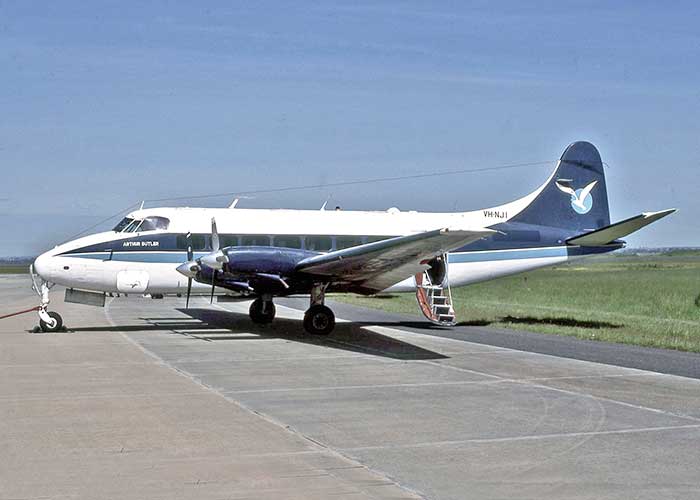
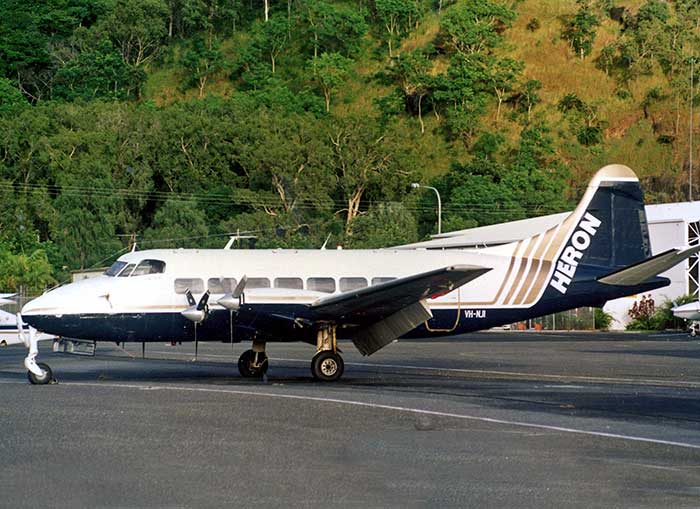
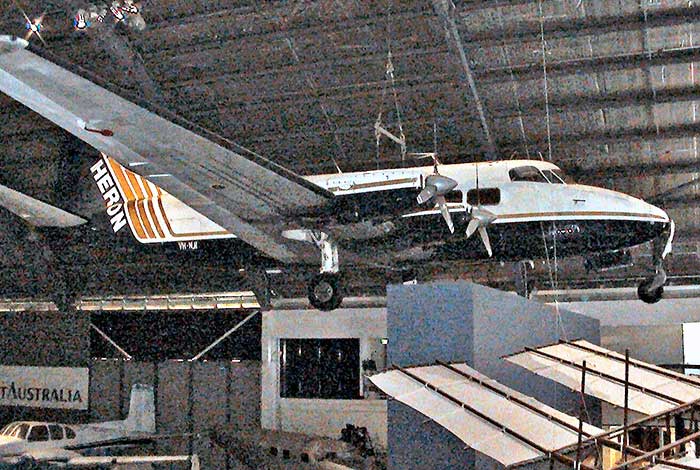
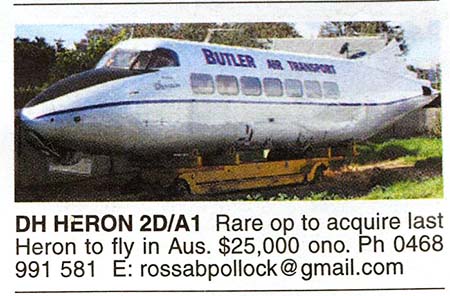
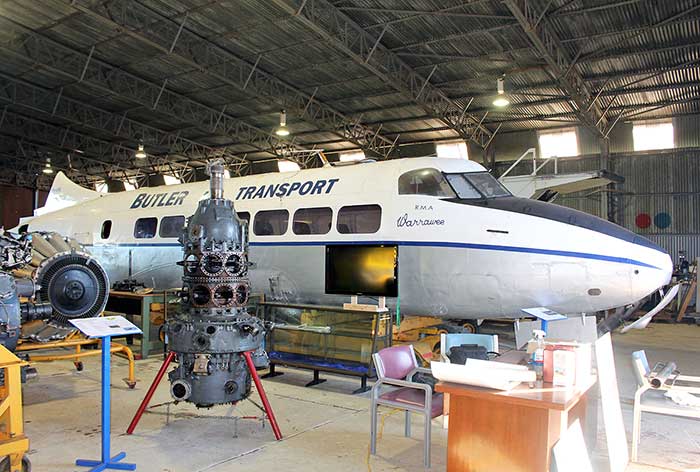
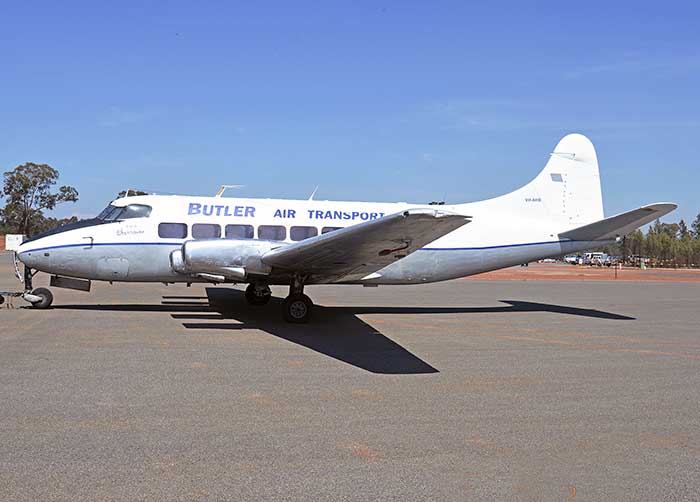
Photo by Peter Ricketts
| .55 | Built by De Havilland Aircraft Co Ltd, Hawarden Aerodrome, Chester. Production Heron 2 |
| 4.55 | Registered VR-NAQ West African Airways Corp, Lagos Nigeria |
| 13.4.55 | DH hand-over date to WAAC |
| 28.8.60 | VR-NAQ arrived London-Gatwick for disposal by Overseas Aviation Ltd |
| 17.3.61 | Registered G-ARKU Overseas Aviation Ltd, Gatwick |
| 28.3.61 | Struck-of British Register, sold to British Admiralty for Royal Navy Fleet Air Arm |
| 3.61 | Royal Navy Fleet Air Arm as Sea Heron C Mk.20 XR443. One of five second-hand Herons acquired by Royal Navy in 1961 for communications duties, designated Sea Heron C Mk.20s with serials XR441 to XR445 |
| 3.90 | Sold at auction of RNFAA aircraft to D. Liddel-Grainger |
| 20.4.90 | Registered G-ODLG David Liddel-Grainger, Ayton Castle, Eyemouth |
| Originally
registered quoting c/n 14092 due confusion caused by "G-ODLG" being
temporarily painted on two Sea Herons purchased by Liddel-Grainger
after the auction. Both were at Booker airfield. The other aircraft
14092 became G-ORSJ and was broken up for parts at Booker. | |
| 2.1.92 | Change of ownership: RSJ Aviation International Ltd, Farnborough Airport |
| 93 | Purchased at Booker by John Ives trading as Heron Airlines, Sydney |
| 93 | G-OLDG ferried Booker-Gloucester for preparation for ferry to Australia by Eurojet. |
| 22.7.93 | Registered VH-NJP IBJ International Aviation Consultants Pty Ltd trading as Heron Airlines Pty Ltd, Sydney NSW |
| 27.9.93 | VH-NJP departed Staverton, Glos on delivery flight to Australia flown by John Ives |
| 8.10.93 | Arrived Sydney after a 27 stop delivery flight |
| Delays
with CASA Australian certification to allow passenger charter. The
regulator discouraged the use of older type commercial aircraft forpassenger work. | |
| 14.1.95 | VH-NJP visited Adelaide, basic Royal Navy grey & white scheme, "Heron Airlines" above windows name "E.J.Connellan" on nose |
| 2.10.96 | Flew Sydney-Maitland NSW, reported to be VH-NJP's first revenue operation |
| .98 | Retired at Bankstown |
| 12.2.01 | noted at Banktown having maintenance |
| 18.10.01 | Test flight Bankstown after overhaul |
| .01 | Retired at Bankstown |
| 10.02 | noted Bankstown, Heron Airlines paint scheme, not flying |
| .03 | Sold to Al Mahatta Museum, Sharjah United Arab Emirates |
| 9.03 | Repainted at Bankstown as "Gulf Aviation G-ANFE" |
| .03 | Dismantled and shipped from Sydney to Sharjah |
| 04 | Displayed
at Al Mahatta Museum, Sharjah as "Gulf Aviation G-ANFE" alongside a
DH.104 Dove, Douglas DC-3 and Avro Anson all painted in Gulf Aviation
markings. (G-ANFE had been a Heron with Gulf Aviation Co, a BOAC associate company based at Bahrein which operated airline services to Arabian Gulf area, including Sharjah) |
| Currently displayed Sharjah |
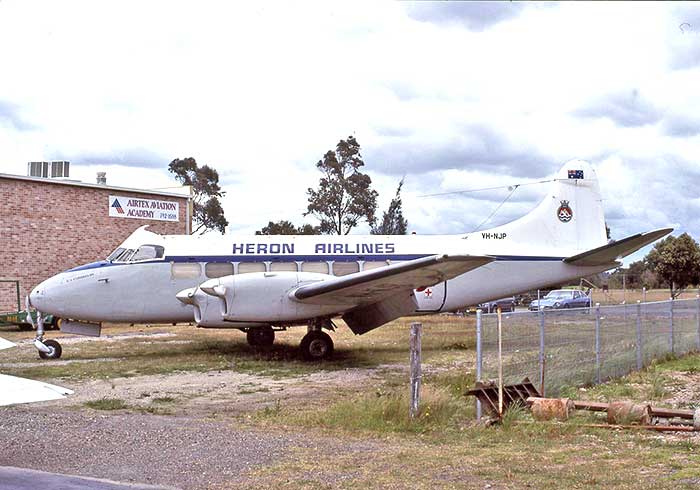
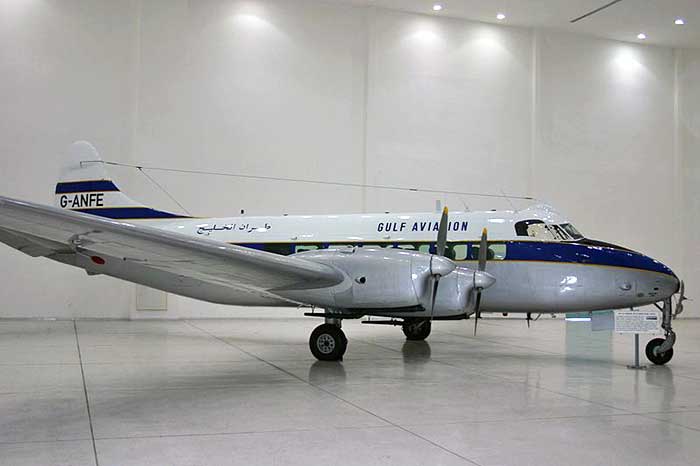
| .57 | Built by De Havilland Aircraft Co Ltd, Hawarden Aerodrome, Chester. Production Heron 2D |
| 6.1.58 | Registered YV-P-AEB Cia. Shell de Venezolana S.A. |
| 67 | Converted to Riley Heron with Lycoming engines by Riley Aeronautics Corporation in Florida |
| 10.68 | Reregistered YV-P-AEC Cia. Shell de Venezolana S.A. |
| (YV-O-MMH-5) Not Taken Up when sale cancelled to Venezuala Ministry of Mines | |
| .74 | Reregistered YV-284P |
| .86 | Sold to Air Raratonga, Rarotonga, Cook Islands, South PAcific |
| 7.7.86 | Registered ZK-TAJ Air Rarotonga, Raratonga, Cook Islands (Aviation administration in the Cook Islands is provided by the New Zealand Government) |
| 9.7.86 | ZK-TAJ noted at Honolulu on delivery flight to Rarotonga |
| .90 | Air Rarotonga's single Heron was replaced by a Bandeirante, flown to Auckland for resale |
| 12.90 | ZK-TAJ advertised in NZ aviation magazines: DH RILEY HERON COMMUTER ZK-TAJ Low Cost Entry Level. 15 Pax Com.Only 10,000 Hrs since new. New Lycoming IO-540 Engines. King IFR Avionics, Transponder, HF, Intercom. Complete Records From Day One. Extensive Spares Package. New C of A and Major Check. Excellent paint and interior. Immediate Delivery. All Manuals Included. Type Training Avail. Delivered Ex Ardmore |
| 6.91 | Sold to Vincent Aviation, Wellington NZ |
| Delivery delayed while wing spar work carried out in Fiji | |
| 7.2.92 | Arrived Auckland on ferry from Fiji via Norfolk Island |
| 24.2.92 | Final flight: flew Wellington-Palmerston North for maintenance by Fieldair. |
| Serious corrosion found in wing structure. Aircraft grounded. | |
| 9.92 | Shipped dismantled to Launceston for
structural repairs for Vincent Aviation to be carried out by Airlines
of Tasmania. Shipping container arrived Launceston Airport 15.9.92 |
| On detailed inspection the corrosion was found to beyond repair. Airframe sold "as is"for parts use to Airlines of Tasmania | |
| In
6.92 Vincent Aviation replaced the grounded ZK-TAJ with Riley Heron
VH-KAM leased from Airlines of Tasmania. The Lycoming power plants from
ZK-TAJ were installed in VH-KAM for the period of the lease. | |
| 4.8.93 | ZK-TAJ struck-off Civil Register |
| (Peter
Vincent, founder of Vincent Aviation subsequently took succesful legal
action against the Civil Aviation Authority of New Zealandover their issuing a CofA to ZK-TAJ which poved to be unairworthy) | |
| 6.11.96 | ZK-TAJ's
dismembered airframe sections were carted away from the Airlines of
Tasmania hangar at Launceston Airport by a scrap metal dealer |
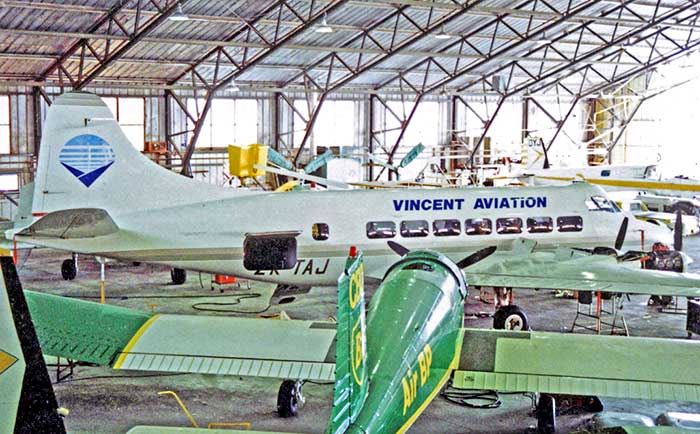
ZK-TAJ at Palmerston North NZ 28 February 1992 during the inspection that would not be comnpleted.
Photo by R.A.Scholefield
Photo by R.A.Scholefield
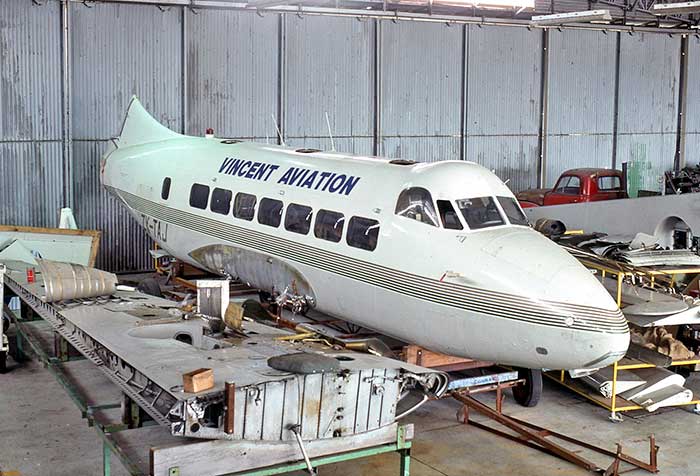
It's hard to believe this Canadian Saunders ST-27 twin-turboprop stretched Heron conversion C-FZZP was previously Connair's VH-CLR.
ST-27s could efficiently carry 23 passengers on two P&W PT-6As. Twelve were built at Gimli, Manitoba before the venture was shut down when Government financial support was withdrawn in 1976. Photographed by the compiler at Toronto Island Airport in October 1981, with Toronto city and CN Tower behind.

- Australian Civil Aircraft Register, Department of Civil Aviation and its successors
- British Civil Aircraft Register: g-info website
- Department of Civil Aviation aircraft files: National Archives of Australia, Melbourne
- British Civil Aircraft Since 1919, Volume 2, A.J..Jackson, Putnam London 1973
- De Havilland Aircraft Since 1909, A.J.Jackson, Putnam London 1978
- De Havilland Heron, J. Graham Cowell, 1983
- SE Asia Civil Aircraft Registers, Air Britain 1979: VT- historical Register
- Civil Aircraft Registers of Venezuala, Air Britain 1983
- Failure of Triumph, E.J. Connellan, Paradigm Investments, Alice Springs NT
- Flight, Memoirs 1912-1958, C.Arthur Butler, Anna Yates 2008
- Serving The Outback - The story of Connellan Airways, Keith Simpson, Propliner Annuals 2018-19
- Romancing The Heron, Gordon Reid, Australian Aviation magazine, November 1986
- Tom Young, T.R.Young interview recorded by Greg Banfield, AHSA Aviation Heritage Vol.32 No.4, 2001
- Journal - Aviation Historical Society of Australia, and Civil Register updates, 1960 onwards
- NSW Air Log, monthly 1964
- Australian Air Log, monthly newsletter 1965-1968
- Western Airletter, monthly newsletter, Perth WA 1974-1983
- Aussie Airliners site: http://www.aussieairliners.org/dehavilland%20heron/vh-ahb/vhahb.html
- Aviation after Cyclone Tracy, Ron Cuskelly: http://www.adastron.com/cyclone-tracy/tracy.htm